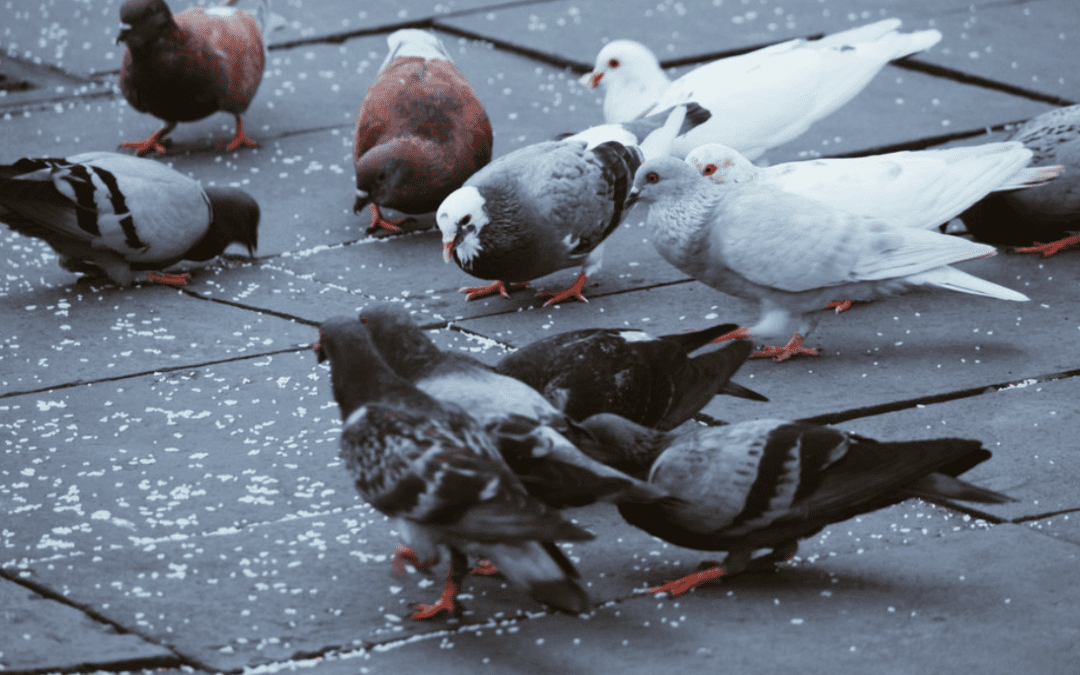
by Pigeon Patrol | Mar 7, 2022 | MBCA, pet bird, Pigeon Control, Pigeon Droppings, Pigeon Patrol's Services, Pigeon Predators
The world is urbanising rapidly, and it is predicted that by 2050, 66% of the global human population will be living in urban areas. Urbanisation is characterised by land-use changes such as increased residential housing, business development and transport infrastructure, resulting in habitat loss and fragmentation. Over the past two decades, interest has grown in how urbanisation influences fundamental aspects of avian biology such as life-history strategies, survival, breeding performance, behaviour and individual health. Here, we review current knowledge on how urbanisation influences the nesting biology of birds, which determines important fitness-associated processes such as nest predation and community assembly. We identify three major research areas: (i) nest sites of birds in urban areas, (ii) the composition of their nests, and (iii) how these aspects of their nesting biology influence their persistence (and therefore conservation efforts) in urban areas. We show that birds inhabiting urban areas nest in a wide variety of locations, some beneficial through exploitation of otherwise relatively empty avian ecological niches, but others detrimental when birds breed in ecological traps. We describe urban-associated changes in nesting materials such as plastic and cigarette butts, and discuss several functional hypotheses that propose the adaptive value and potential costs of this new nesting strategy. Urban areas provide a relatively new habitat in which to conserve birds, and we show that nestboxes and other artificial nest sites can be used successfully to conserve some, but not all, bird species. Finally, we identify those subject areas that warrant further research attention in the hope of advancing our understanding of the nesting biology of birds in urban areas.
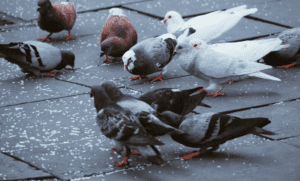
Source
Pigeon Patrol Products & Services is the leading manufacturer and distributor of bird deterrent (control) products in Canada. Pigeon Patrol products have solved pest bird problems in industrial, commercial, and residential settings since 2000, by using safe and humane bird deterrents with only bird and animal friendly solutions. At Pigeon Patrol, we manufacture and offer a variety of bird deterrents, ranging from Ultra-flex Bird Spikes with UV protection, Bird Netting, 4-S Bird Gel and the best Ultrasonic and audible sound devices on the market today.
Voted Best Canadian wholesaler for Bird Deterrent products ten years in a row.
Contact us at 1- 877– 4– NO-BIRD, (604) 585-9279 or visit our website at www.pigeonpatrol.ca
Pigeon/Pigeon Patrol / Pigeons Roosting / Vancouver Pigeon Control /Bird Spikes / Bird Control / Bird Deterrent / Pigeon Deterrent? Surrey Pigeon Control / Pest /Seagull deterrent / Vancouver Pigeon Blog / Birds Inside Home / Pigeons in the cities / Ice Pigeons/ What to do about pigeons/ sparrows , Damage by Sparrows, How To Keep Raccoons Away, Why Are Raccoons Considered Pests/ De-fence / Pigeon Nesting/ Bird Droppings / Pigeon Dropping/ woodpecker control/ Professional Bird Control Company/ Keep The Birds Away/ Birds/rats/ seagull/pigeon/woodpecker/ dove/sparrow/pidgeon control/pidgeon problem/ pidgeon control/flying rats/ pigeon Problems/ bird netting/bird gel/bird spray/bird nails/ bird guard
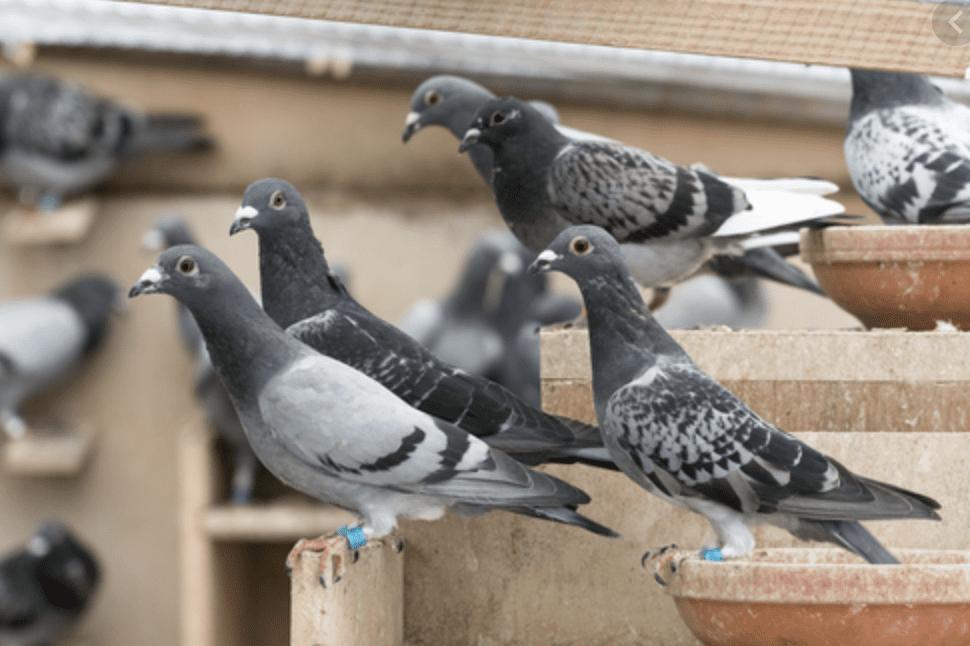
by Pigeon Patrol | Mar 7, 2022 | history of pigeons, MBCA, pet bird, Pigeon Control, Pigeon Droppings, Pigeon Patrol's Services, Pigeon Predators
Impatient for winter to be over, we had put on our boots to go seeking signs of spring but had instead found a sign of the previous summer. We must have walked past this thicket a score of times last summer without ever noticing birds around it, but here is a bird’s nest among the branches, at eye level, in plain sight now that winter has stripped away the last of the leaves.
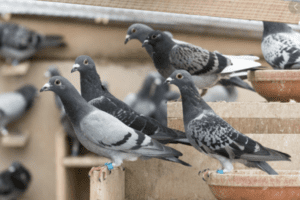
It would be easy enough to pass it by. If we pause to look closely, though, it becomes more intriguing. We may never know what kind of bird built the nest, because there are several species here that might construct this type: an open-cup shape lashed into a three-way fork in an upright twig. But it inspires a sense of wonder beyond mere questions about identification. Somehow a small bird knew how to gather the myriad materials for this structure. Somehow this bird arranged scores of small pieces of twig and grass and weed and bark, weaving them together with such precision that the nest is still sturdy and secure after being exposed to the winter’s rain and wind. Considered in the proper light, this little bundle of dried vegetation is really a small miracle.
“My favorite palette is the color of winter decay,” says photographic artist Sharon Beals. It’s 7 a.m. in San Francisco, but she is already on her way out the door to work on her project for the day. Much of her professional photography takes her outside, “wandering a river for hours, looking at bugs, muck, and minnows,” as she says, or photographing native plants or their pollinators. Today, though, she will spend up to 11 hours in a museum, examining birds’ nests and photographing many of them. The results will add to her growing collection of nest portraits—extraordinarily detailed images that have already wowed scientists and artists alike.
Beals became immersed in this subject almost by chance when a friend, knowing her fascination with the subtle minutiae of nature, brought her an abandoned bird nest. Studying it, she knew she had to find a way to capture its intricacy. Using a very high-resolution flatbed scanner, she made images of this nest, and then another, and another.
But problems loomed. For one thing, she says, after turning a nest upside down on the scanner, she might have to spend hours cleaning all the dust that falls from the nests off the images in Photoshop. For another, as she discovered, possessing these nests was illegal.
Beals overcame the first challenge by moving to very high-resolution cameras and by taking multiple exposures, focusing on different planes, then melding the images together. But the second problem was tougher. The laws protecting U.S. birds are far more sweeping than most people imagine. Without special permits, it is illegal for private citizens to possess most species of native birds, or their feathers, or their eggs, or even their abandoned nests. The laws may seem excessive, but they were enacted at a time when our birds were under siege from commercial plume hunters and recreational egg collectors, and they were written to be wide-ranging and inclusive. Rather than give up or break the law, Beals turned to the Museum of Vertebrate Zoology and the California Academy of Sciences, and soon had permission to come in and photograph nests from among the hundreds in the institutions’ specimen collections.
The popular image of natural history museums may be of a handful of stuffed creatures on public display in glass cases, but most keep the majority of their specimens in research collections out of public view. The nests at the California Academy of Sciences were mostly collected decades ago, at a time when relatively little was known about birds’ habits. These specimens provided basic data points then, and they continue to be scientifically valuable today.
For Sharon Beals, they also provided a treasure trove of artistic possibilities. She spent days at the academy, examining and photographing nests. “These first images gave me the satisfaction of seeing the materials on almost a cellular level,” she says. “I loved the quiet, subdued palette, and the shapes created by the form-follows-function art of the nest builders themselves. I loved the amazing variety of content and construction, the way the materials became like line and brushstroke.” When she began printing the images larger than life, on sheets of fine etching paper two feet across, others shared her enthusiasm. Visitors to her studio were fascinated. Almost invariably they became intensely curious. Beals had found a way to make people see the nests, truly see them, as cause for wonder and for endless questions about the birds that built them.
Birds do not live in their nests the way humans live in their houses. A few species, such as some wrens, will use them as shelters to sleep in at night, but they are the exceptions. For the majority, the nest is just a cradle. Built to hold the eggs and the helpless young, it is abandoned once the young birds are old enough to leave. In most cases it is never used again.
There is evidence that some dinosaurs built primitive nests on the ground and even cared for their hatchlings there. Today many creatures besides birds—from wasps to mice to alligators—shelter their young or their eggs in nests that they construct themselves. But for variety of placement and material, and for sheer complexity of design, nothing can compare with birds’ nests. Especially among smaller birds, nests are often remarkable for their inventive use of local materials to provide support, shelter, and camouflage. The nests are tiny marvels of disposable architecture.
The skill to create them comes almost entirely from instinct (although there is evidence that young adult birds, making their first nests, do improve with practice). Studies have shown that at least some birds, hand-raised in captivity, can build a nest typical of their own species without ever having seen one. The instinct to do this must be flexible, because the locations and materials available for nests in the wild vary, but it must be based on a considerable amount of precision as well.
Even a small bird’s relatively simple nest may be composed of several kinds of material used for different purposes. For example, a white-crowned sparrow’s may have coarse twigs at the base, finer twigs and weeds intertwined with rootlets and bark strips to form the open cup, dry leaves in the outer edge, and fine grasses and other soft materials molded into an inner lining. And that’s just a simple number. A more complex nest, such as the long hanging pouch of an American oriole, may involve actual weaving or sophisticated knots tied in long plant fibers, and it may take days of intense effort to build.
Most birds are opportunistic when it comes to building materials, and will readily incorporate manmade items into their nests if they fit basic requirements of size and texture. Paper, string, nails, pieces of wire, and bits of fabric regularly show up in the handiwork of suburban birds. In some areas house finches have become a minor nuisance by dismantling nylon window screens to use the strands for their nests.
In many cases, though, the materials chosen must have specific properties. Studies of nesting European starlings have found that the birds were selecting certain plants, such as wild carrot and yarrow, containing chemicals that would inhibit the growth of mites and other parasites. In eastern North America the great crested flycatcher often adds a piece of shed snakeskin, and the power of suggestion imparted may help deter predators or other intruders. Chipping sparrows often use animal hair (gathered in farmyards, or even plucked from startled pets) for their nest lining. Feathers are also ideal for soft, insulating lining material. Big birds like quail or ducks use their own down feathers for this purpose, but swallows and other small birds prefer feathers dropped by larger birds. A truly extreme example of material gathering is practiced by certain tropical swifts, fast-flying small birds that will actually strike much larger birds in midair to knock feathers loose.
As a very general rule, females are the skilled builders. For many species they do all the construction, including some (such as hummingbirds) for which males abdicate any responsibility for helping with the nest or young. In other cases, the male provides the basic foundation and the female adds the detailed lining. A male marsh wren may build 20 or more “dummy nests” around his territory; the female chooses one, adds lining, and uses it as the actual site for the eggs. The male’s building spree is not wasted effort: The presence of all those decoys may provide some protection for the real one, as predators tire of raiding nests that turn out to be empty.
Some of the most impressive nests are also among the smallest. A hummingbird nest is a wondrous creation of tiny plant fibers, mosses, and spiderwebs, so small that a 50-cent piece would completely cover it. It is as soft as felt but strong, with the spiderwebs making it pliable enough to stretch and expand as the rambunctious young hummers grow and exercise in it. Many hummingbirds will camouflage the outside with bits of lichen. At a distance such an object looks, for all the world, like a natural bump or knob on the branch, thereby deceiving potential predators in the mother bird’s absence.
At the opposite extreme are eagles. A pair of bald eagles may use the same nest for years, adding material to it annually until it becomes huge (an extreme example can reach a depth of 20 feet and a weight exceeding two tons). Such a nest is merely a ramshackle heap of sticks, hardly an admirable piece of avian architecture, but it does have its admirers: House sparrows and other small birds sometimes tuck their own nests into the lower crevices, and great horned owls may commandeer the entire nest, perhaps even driving the eagles from their aerie.
The finest nests are crafted by smaller birds, however, and the majority are never reused, not even by their original builders. It seems all the more remarkable that birds should create these intricate structures for such ephemeral use. It seems ironic, too, that most of us are not legally allowed to possess these nests, even after they have been abandoned. But when we are lucky enough to find them in the wild, or see them revealed in works of photographic art like the ones reproduced here, we cannot avoid holding them and the birds that made them in absolute awe.
Source
Pigeon Patrol Products & Services is the leading manufacturer and distributor of bird deterrent (control) products in Canada. Pigeon Patrol products have solved pest bird problems in industrial, commercial, and residential settings since 2000, by using safe and humane bird deterrents with only bird and animal friendly solutions. At Pigeon Patrol, we manufacture and offer a variety of bird deterrents, ranging from Ultra-flex Bird Spikes with UV protection, Bird Netting, 4-S Bird Gel and the best Ultrasonic and audible sound devices on the market today.
Voted Best Canadian wholesaler for Bird Deterrent products ten years in a row.
Contact us at 1- 877– 4– NO-BIRD, (604) 585-9279 or visit our website at www.pigeonpatrol.ca
Pigeon/Pigeon Patrol / Pigeons Roosting / Vancouver Pigeon Control /Bird Spikes / Bird Control / Bird Deterrent / Pigeon Deterrent? Surrey Pigeon Control / Pest /Seagull deterrent / Vancouver Pigeon Blog / Birds Inside Home / Pigeons in the cities / Ice Pigeons/ What to do about pigeons/ sparrows , Damage by Sparrows, How To Keep Raccoons Away, Why Are Raccoons Considered Pests/ De-fence / Pigeon Nesting/ Bird Droppings / Pigeon Dropping/ woodpecker control/ Professional Bird Control Company/ Keep The Birds Away/ Birds/rats/ seagull/pigeon/woodpecker/ dove/sparrow/pidgeon control/pidgeon problem/ pidgeon control/flying rats/ pigeon Problems/ bird netting/bird gel/bird spray/bird nails/ bird guard
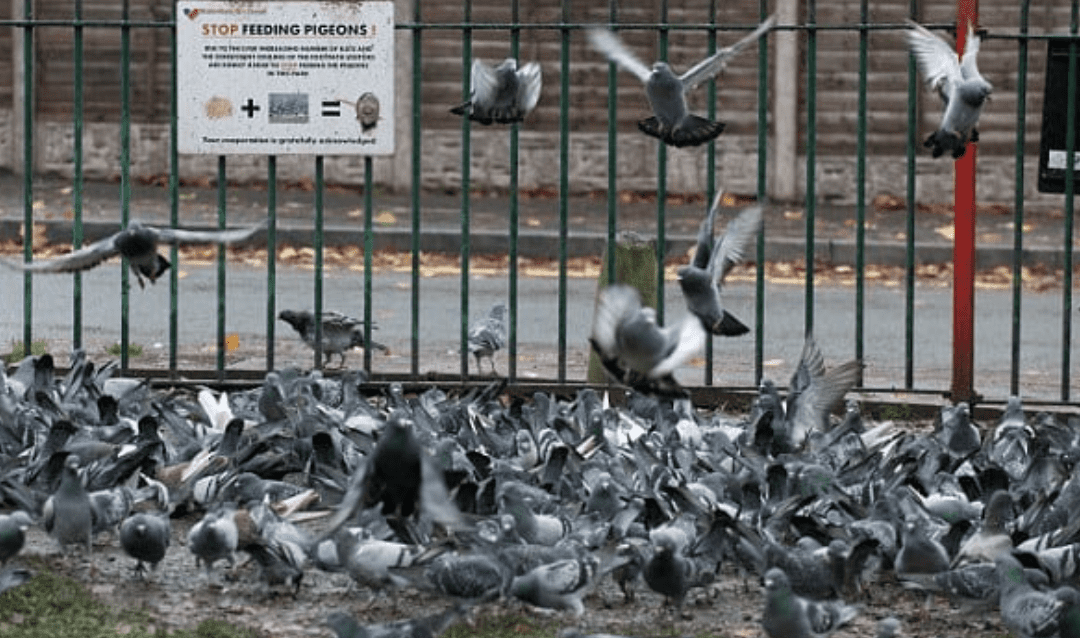
by Pigeon Patrol | Mar 7, 2022 | MBCA, pet bird, Pigeon Control, Pigeon Droppings, Pigeon Patrol's Services, Pigeon Predators
This morning as I was getting some worked finished, I noticed two crows on the roof across our ally. They had a large object which I first thought was something from the dumpster and then noticed what looked like it had chicken feet. I opened the window to get photos. Because it was cold out, the heat from my window made for some fierce shimmer and the photos are blurry…but you get the idea of what they are eating. Again, if you don’t like gross stuff, or don’t like the whole predator prey relationship thing, stop reading now.
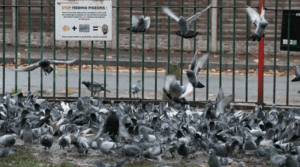
 When I first saw the feet, I was reminded of the quail that we get to feed the birds at The Raptor Center, but there are no quail around here. Then I realized that the bird the crows were eating had only pin feathers–it was a young bird from a nest. By the size, I realized that they were eating a pigeon nesting.
When I first saw the feet, I was reminded of the quail that we get to feed the birds at The Raptor Center, but there are no quail around here. Then I realized that the bird the crows were eating had only pin feathers–it was a young bird from a nest. By the size, I realized that they were eating a pigeon nesting.
 The two crows made short order of the chick. By the size and development, I would guess that the pigeon was about ten days old–which is interesting in and of itself. If the pigeon chick was about ten days old, the egg would have been laid 18 days before that, so the pigeon parents were busy in early March–at least two snow storms ago.
The two crows made short order of the chick. By the size and development, I would guess that the pigeon was about ten days old–which is interesting in and of itself. If the pigeon chick was about ten days old, the egg would have been laid 18 days before that, so the pigeon parents were busy in early March–at least two snow storms ago.
The pigeon nest was tucked in a nook on the roof of an apartment building just to the right of where the crows were eating. I’ve seen pigeons in and out of there all winter and assumed roosting–I didn’t guess that they were on eggs last month.
 When the crows were finished, I went back to business in my apartment. About fifteen minutes later I found them working on another chick. That surprised me. It makes sense to clean out a whole robin nest–those are small chicks, but a pigeon chick is fairly large, I was surprised that they ate both nestlings right away, but when you find a huge protein source like that and you are in the process of laying eggs yourself, you’re not gonna be able to resist it.
When the crows were finished, I went back to business in my apartment. About fifteen minutes later I found them working on another chick. That surprised me. It makes sense to clean out a whole robin nest–those are small chicks, but a pigeon chick is fairly large, I was surprised that they ate both nestlings right away, but when you find a huge protein source like that and you are in the process of laying eggs yourself, you’re not gonna be able to resist it.
 And let’s keep in mind that this is gross and it may not be pretty to watch a crow clean out a nest–but they are not the only ones to do it. Blue jays do it, hawks do it, owls do it–even woodpeckers do it. Heck, even nut job humans in England do it. Crows are just more obvious about it.
And let’s keep in mind that this is gross and it may not be pretty to watch a crow clean out a nest–but they are not the only ones to do it. Blue jays do it, hawks do it, owls do it–even woodpeckers do it. Heck, even nut job humans in England do it. Crows are just more obvious about it.
Source
Pigeon Patrol Products & Services is the leading manufacturer and distributor of bird deterrent (control) products in Canada. Pigeon Patrol products have solved pest bird problems in industrial, commercial, and residential settings since 2000, by using safe and humane bird deterrents with only bird and animal friendly solutions. At Pigeon Patrol, we manufacture and offer a variety of bird deterrents, ranging from Ultra-flex Bird Spikes with UV protection, Bird Netting, 4-S Bird Gel and the best Ultrasonic and audible sound devices on the market today.
Voted Best Canadian wholesaler for Bird Deterrent products ten years in a row.
Contact us at 1- 877– 4– NO-BIRD, (604) 585-9279 or visit our website at www.pigeonpatrol.ca
Pigeon/Pigeon Patrol / Pigeons Roosting / Vancouver Pigeon Control /Bird Spikes / Bird Control / Bird Deterrent / Pigeon Deterrent? Surrey Pigeon Control / Pest /Seagull deterrent / Vancouver Pigeon Blog / Birds Inside Home / Pigeons in the cities / Ice Pigeons/ What to do about pigeons/ sparrows , Damage by Sparrows, How To Keep Raccoons Away, Why Are Raccoons Considered Pests/ De-fence / Pigeon Nesting/ Bird Droppings / Pigeon Dropping/ woodpecker control/ Professional Bird Control Company/ Keep The Birds Away/ Birds/rats/ seagull/pigeon/woodpecker/ dove/sparrow/pidgeon control/pidgeon problem/ pidgeon control/flying rats/ pigeon Problems/ bird netting/bird gel/bird spray/bird nails/ bird guard
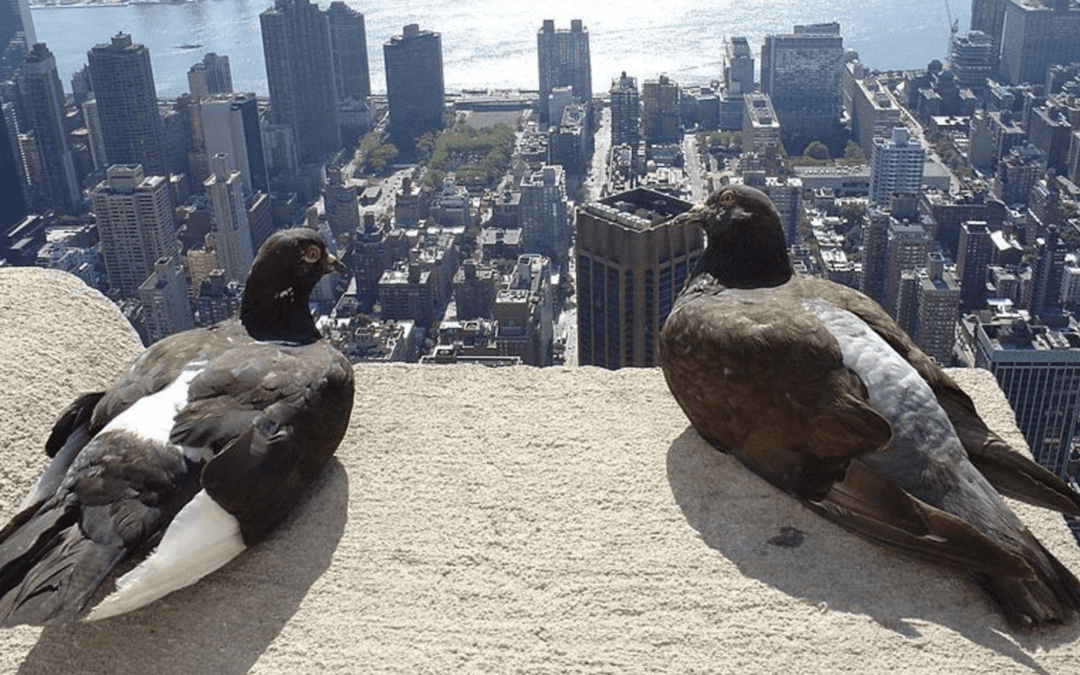
by Pigeon Patrol | Mar 7, 2022 | Bird Spike, Pigeon Spikes, Pigeons, Pigeons in the News, Raccoons, Sparrows, UltraSonic Bird Control
How do animals become problems? Drawing on interactionist theories of social problems and cultural geography, I argue that the construction of animals as problems relies upon cultural understandings of nature/culture relationships, which in turn entail “imaginative geographies.” Specifically, modernity posits a firm boundary between nature and culture. Animals have their place, but are experienced as “out of place”—and often problematic—when they are perceived to transgress spaces designated for human habitation. Relying on New York Times articles from 1851 to 2006, and articles from 51 other newspapers from 1980 to 2006, this article focuses on the process by which pigeons as a species were problematized. I contend that pigeons have come to represent the antithesis of the ideal metropolis, which is orderly and sanitized, with nature subdued and compartmentalized. While typified as a health issue, the pigeon’s primary “offense” is that it “pollutes” habitats dedicated for human use. The catch phrase “rats with wings” neatly summarizes society’s evaluations of, and anxieties about, this bird. This metaphor reflects a framing of pigeons by claims-makers that renders them out of place in the cityscape. This study expands social problems theorizing to more thoroughly account for animals and the role of space.
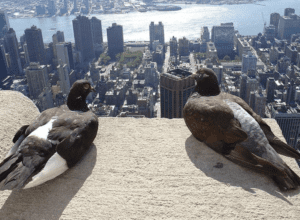
Source
Pigeon Patrol Products & Services is the leading manufacturer and distributor of bird deterrent (control) products in Canada. Pigeon Patrol products have solved pest bird problems in industrial, commercial, and residential settings since 2000, by using safe and humane bird deterrents with only bird and animal friendly solutions. At Pigeon Patrol, we manufacture and offer a variety of bird deterrents, ranging from Ultra-flex Bird Spikes with UV protection, Bird Netting, 4-S Bird Gel and the best Ultrasonic and audible sound devices on the market today.
Voted Best Canadian wholesaler for Bird Deterrent products ten years in a row.
Contact us at 1- 877– 4– NO-BIRD, (604) 585-9279 or visit our website at www.pigeonpatrol.ca
Pigeon/Pigeon Patrol / Pigeons Roosting / Vancouver Pigeon Control /Bird Spikes / Bird Control / Bird Deterrent / Pigeon Deterrent? Surrey Pigeon Control / Pest /Seagull deterrent / Vancouver Pigeon Blog / Birds Inside Home / Pigeons in the cities / Ice Pigeons/ What to do about pigeons/ sparrows , Damage by Sparrows, How To Keep Raccoons Away, Why Are Raccoons Considered Pests/ De-fence / Pigeon Nesting/ Bird Droppings / Pigeon Dropping/ woodpecker control/ Professional Bird Control Company/ Keep The Birds Away/ Birds/rats/ seagull/pigeon/woodpecker/ dove/sparrow/pidgeon control/pidgeon problem/ pidgeon control/flying rats/ pigeon Problems/ bird netting/bird gel/bird spray/bird nails/ bird guard
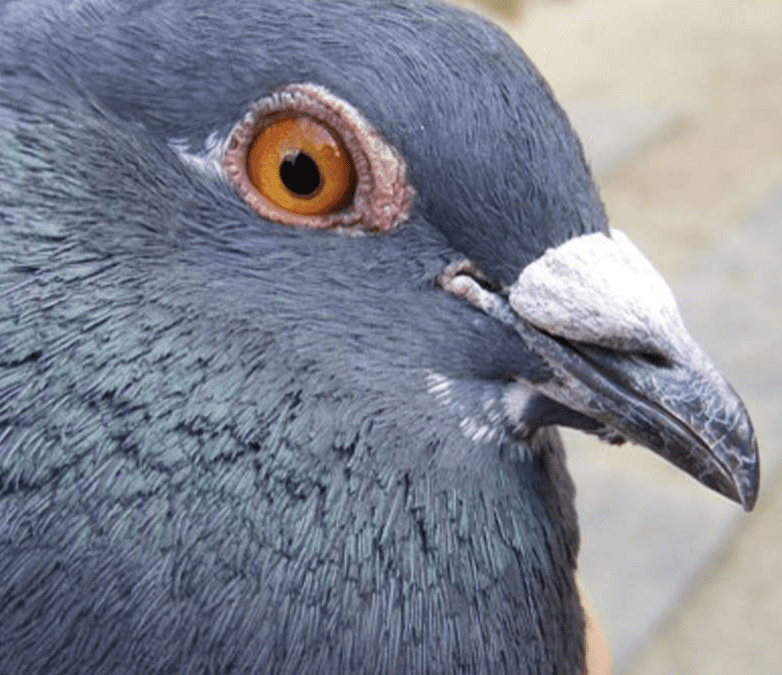
by Pigeon Patrol | Mar 7, 2022 | 4-S Gel Bird repellent, Animal Deterrent Products, Bird Deterrent Products, Bird Law, Bird Netting, Bird Spikes
Being a peregrine fanatic I’m kind of fond of pigeons – at least from the prey point of view – so when I was in downtown Pittsburgh on Sunday I stopped by Mellon Square to check out the scene.
Even for a peregrine falcon the number of pigeons at Mellon Square is way too much of a good thing. I counted more than 150 and I couldn’t see all of them. The pigeons outnumbered people more than 30 to 1.
This explains why peregrines hang out on the Oliver Building window sills. It’s like visiting an all-you-can-eat restaurant. The food may not be that great but there’s so much of it!
This kind of pigeon over-population repulses most people and they want a quick fix, the quickest being poison. But if you poison a pigeon, you’ll poison a peregrine. After a culling episode pigeons reproduce fast to fill the void – in fact lethal control actually increases the flock – but the peregrines take years to recover. And peregrines are endangered in Pennsylvania. It’s bad, bad, bad to poison an endangered species.
So what to do?
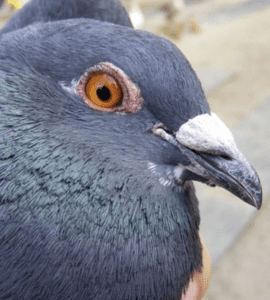
Pigeons need two things to reach the numbers found at Mellon Square: lots of food and places to nest. They reproduce in direct proportion to their food supply. If food is scarce some won’t nest at all. If food is plentiful they lay the next clutch of eggs before the first set has hatched, producing more than 12 chicks per year.
The food problem is obvious. Sidewalks at Mellon Square are coated with bird seed. Control the food source (the people who feed them) and you’ve got most of the problem licked. To make a really dramatic difference, control the nest sites as well.
City pigeons nest on buildings and bridges. They also nest in buildings. Find the buildings involved and spend the time and money to block the access holes. Last summer the University of Pittsburgh cleaned the Cathedral of Learning and blocked off the pigeon nest holes as part of the cleaning job. One year later there are far fewer pigeons at Schenley Plaza.
And finally, there’s a foolproof solution that makes both the pigeon-feeders and the pigeon-haters happy. Many European cities have solved their pigeon problem permanently by building dovecotes and pigeon lofts. Yes, they built nest sites. They control the population at the dovecotes by substituting dummy eggs and they control the food level by giving pigeon lovers an approved place to feed and interact with the birds.
This keeps the pigeons and the birdseed off the street. An elegant solution.
Source
Pigeon Patrol Products & Services is the leading manufacturer and distributor of bird deterrent (control) products in Canada. Pigeon Patrol products have solved pest bird problems in industrial, commercial, and residential settings since 2000, by using safe and humane bird deterrents with only bird and animal friendly solutions. At Pigeon Patrol, we manufacture and offer a variety of bird deterrents, ranging from Ultra-flex Bird Spikes with UV protection, Bird Netting, 4-S Bird Gel and the best Ultrasonic and audible sound devices on the market today.
Voted Best Canadian wholesaler for Bird Deterrent products ten years in a row.
Contact us at 1- 877– 4– NO-BIRD, (604) 585-9279 or visit our website at www.pigeonpatrol.ca
Pigeon/Pigeon Patrol / Pigeons Roosting / Vancouver Pigeon Control /Bird Spikes / Bird Control / Bird Deterrent / Pigeon Deterrent? Surrey Pigeon Control / Pest /Seagull deterrent / Vancouver Pigeon Blog / Birds Inside Home / Pigeons in the cities / Ice Pigeons/ What to do about pigeons/ sparrows , Damage by Sparrows, How To Keep Raccoons Away, Why Are Raccoons Considered Pests/ De-fence / Pigeon Nesting/ Bird Droppings / Pigeon Dropping/ woodpecker control/ Professional Bird Control Company/ Keep The Birds Away/ Birds/rats/ seagull/pigeon/woodpecker/ dove/sparrow/pidgeon control/pidgeon problem/ pidgeon control/flying rats/ pigeon Problems/ bird netting/bird gel/bird spray/bird nails/ bird guard
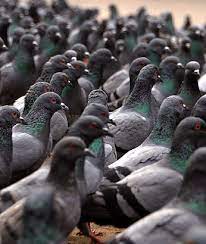
by Pigeon Patrol | Feb 22, 2022 | Bird Spike, Pigeon Predators, Pigeon Spikes, Pigeons, Pigeons in the News, Raccoons, Sparrows, UltraSonic Bird Control
Though they’re often described as “rats with wings” (a phrase popularized by the movie Stardust Memories), pigeons are actually pretty cool. From homing instincts to misleading rump feathers, here are 15 things you might not know about these avian adventurers.

1. THEY MIGHT BE THE FIRST DOMESTICATED BIRD.
The common city pigeon (Columba livia), also known as the rock pigeon, might be the first bird humankind ever domesticated. You can see them in art dating back as far as 4500 BCE in modern Iraq, and they’ve been a valuable source of food for thousands of years.
2. THEY WON OVER CHARLES DARWIN—AND NIKOLA TESLA.
Pigeon-breeding was a common hobby in Victorian England for everyone from well-off businessmen to average Joes, leading to some fantastically weird birds. Few hobbyists had more enthusiasm for the breeding process than Charles Darwin, who owned a diverse flock, joined London pigeon clubs, and hobnobbed with famous breeders. Darwin’s passion for the birds influenced his 1868 book The Variation of Animals and Plants Under Domestication, which has not one but two chapters about pigeons (dogs and cats share a single chapter).
Nikola Tesla was another great mind who enjoyed pigeons. He used to care for injured wild pigeons in his New York City hotel room. Hands down, Tesla’s favorite was a white female—about whom he once said, “I loved that pigeon, I loved her as a man loves a woman and she loved me. When she was ill, I knew and understood; she came to my room and I stayed beside her for days. I nursed her back to health. That pigeon was the joy of my life. If she needed me, nothing else mattered. As long as I had her, there was a purpose in my life.” Reportedly, he was inconsolable after she died.
3. THEY UNDERSTAND SPACE AND TIME.
In a 2017 Current Biology study, researchers showed captive pigeons a series of digital lines on a computer screen for either two or eight seconds. Some lines were short, measuring about 2.3 inches across; others were four times longer. The pigeons were trained to evaluate either the length of the line or how long it was displayed. They found that the more time a line was displayed, the longer in length the pigeon judged it to be. The reverse was true too: If the pigeons encountered a longer line, they thought it existed in time for a greater duration. Pigeons, the scientists concluded, understand the concepts of both time and space; the researchers noted “similar results have been found with humans and other primates.”
It’s thought that humans process those concepts with a brain region called the parietal cortex; pigeon brains lack that cortex, so they must have a different way of judging space and time.
4. THEY CAN FIND THEIR WAY BACK TO THE NEST FROM 1300 MILES AWAY.
The birds can do this even if they’ve been transported in isolation—with no visual, olfactory, or magnetic clues—while scientists rotate their cages so they don’t know what direction they’re traveling in. How they do this is a mystery, but people have been exploiting the pigeon’s navigational skills since at least 3000 BCE, when ancient peoples would set caged pigeons free and follow them to nearby land.
Their navigational skills also make pigeons great long-distance messengers. Sports fans in ancient Greece are said to have used trained pigeons to carry the results of the Ancient Olympics. Further east, Genghis Khan stayed in touch with his allies and enemies alike through a pigeon-based postal network.
5. THEY SAVED THOUSANDS OF HUMAN LIVES DURING WORLD WARS I AND II.
Pigeons’ homing talents continued to shape history during the 20th century. In both World Wars, rival nations had huge flocks of pigeon messengers. (America alone had 200,000 at its disposal in WWII.) By delivering critical updates, the avians saved thousands of human lives. One racing bird named Cher Ami completed a mission that led to the rescue of 194 stranded U.S. soldiers on October 4, 1918.
6. TWO PIGEONS ALMOST DISTRACTED FROM THE DISCOVERY OF EVIDENCE OF THE BIG BANG.
In 1964, scientists in Holmdel, New Jersey, heard hissing noises from their antenna that would later prove to be signals from the Big Bang. But when they first heard the sound, they thought it might be, among other things, the poop of two pigeons that were living in the antenna. “We took the pigeons, put them in a box, and mailed them as far away as we could in the company mail to a guy who fancied pigeons,” one of the scientists later recalled. “He looked at them and said these are junk pigeons and let them go and before long they were right back.” But the scientists were able to clean out the antenna and determine that they had not been the cause of the noise. The trap used to catch the birds (before they had to later be, uh, permanently removed) is on view at the Smithsonian Air & Space Museum.
7. YOU CAN TRAIN THEM TO BE ART SNOBS …
Japanese psychologist Shigeru Watanabe and two colleagues earned an Ig Nobel Prize in 1995 for training pigeons, in a lab setting, to recognize the paintings of Claude Monet and Pablo Picasso and to distinguish between the painters. The pigeons were even able to use their knowledge of impressionism and cubism to identify paintings of other artists in those movements. Later, Watanabe taught other pigeons to distinguish watercolor images from pastels. And in a 2009 experiment, captive pigeons he’d borrowed were shown almost two dozen paintings made by students at a Tokyo elementary school, and were taught which ones were considered “good” and which ones were considered “bad.” He then presented them with 10 new paintings and the avian critics managed to correctly guess which ones had earned bad grades from the school’s teacher and a panel of adults. Watanabe’s findings indicate that wild pigeons naturally categorize things on the basis of color, texture, and general appearance.
8. … AND TO DISTINGUISH WRITTEN WORDS.
In a 2016 study, scientists showed that pigeons can differentiate between strings of letters and actual words. Four of the birds built up a vocabulary of between 26 and 58 written English words, and though the birds couldn’t actually read them, they could identify visual patterns and therefore tell them apart. The birds could even identify words they hadn’t seen before.
9. FLUFFY PIGEON FEET MIGHT ACTUALLY BE PARTIAL WINGS.
A few pigeon breeds have fuzzy legs—which hobbyists call “muffs”—rather than scaly ones. According to a 2016 study, the DNA of these fluffy-footed pigeons leads their hind legs to take on some forelimb characteristics, making muffed pigeon legs look distinctly wing-like; they’re also big-boned. Not only do they have feathers, but the hindlimbs are somewhat big-boned, too. According to biologist Mike Shapiro, who led the study, “pigeons’ fancy feathered feet are partially wings.”
10. SOME PIGEONS DISTRACT FALCONS WITH WHITE RUMP FEATHERS.
In a life-or-death situation, a pigeon’s survival could depend upon its color pattern: Research has shown that wild falcons rarely go after pigeons that have a white patch of feathers just above the tail, and when the predators do target these birds, the attacks are rarely successful.
To figure out why this is, Ph.D. student Alberto Palleroni and a team tagged 5235 pigeons in the vicinity of Davis, California. Then, they monitored 1485 falcon-on-pigeon attacks over a seven-year span. The researchers found that although white-rumped pigeons comprised 20 to 25 percent of the area’s pigeon population, they represented less than 2 percent of all the observed pigeons that were killed by falcons; the vast majority of the victims had blue rumps. Palleroni and his team rounded up 756 white- and blue-rumped pigeons and swapped their rump feathers by clipping and pasting white feathers on blue rumps, and vice versa. The falcons had a much easier time spotting and catching the newly blue-rumped pigeons, while the pigeons that received the white feathers saw predation rates plummet.
Close observation revealed that the white patches distract birds of prey. In the wild, falcons dive-bomb other winged animals from above at high speeds. Some pigeons respond by rolling away in midair, and on a spiraling bird, white rump feathers can be eye-catching, which means that a patch of them may divert a hungry raptor’s focus long enough to make the carnivore miscalculate and zip right past its intended victim.
11. DODOS WERE RELATED TO TODAY’S PIGEONS.
Though most of this list focuses on the rock pigeon, there are 308 living species of pigeons and doves. Together, they make up an order of birds known as the columbiformes. The extinct dodo belonged to this group as well.
Flightless and (somewhat) docile, dodos once inhabited Mauritius, an island near Madagascar. The species had no natural predators, but when human sailors arrived with rats, dogs, cats, and pigs, it began to die out, and before the 17th century came to a close, the dodo had vanished altogether. DNA testing has confirmed that pigeons are closely related to the dodo, and the vibrant Nicobar pigeon (above) is its nearest genetic relative. A multi-colored bird with iridescent feathers, this near-threatened creature is found on small islands in the South Pacific and off Asia. Unlike the dodo, it can fly.
12. AT ONE POINT, MORE THAN ONE-QUARTER OF ALL THE BIRDS LIVING IN THE U.S. MAY HAVE BEEN PASSENGER PIGEONS.
Wild/feral rock pigeons reside in all 50 states, which makes it easy to forget that they’re invasive birds. Originally native to Eurasia and northern Africa, the species was (most likely) introduced to North America by French settlers in 1606. At the time, a different kind of columbiform—this one indigenous—was already thriving there: the passenger pigeon (Ectopistes migratorius). As many as 5 billion of them were living in America when England, Spain, and France first started colonizing, and they may have once represented anywhere from 25 to 40 percent of the total U.S. bird population. But by the early 20th century, they had become a rare sight, thanks to overhunting, habitat loss, and a possible genetic diversity issue. The last known passenger pigeon—a captive female named Martha—died on September 1, 1914.
13. THEY’RE REALLY GOOD AT MULTITASKING.
According to one study, they’re more efficient multitaskers than people are. Scientists at Ruhr-Universitat Bochum put together a test group of 15 humans and 12 pigeons and trained all of them to complete two simple jobs (like pressing a keyboard once a light bulb came on). They were also put in situations wherein they’d need to stop working on one job and switch over to another. In some trials, the participants had to make the change immediately. During these test runs, humans and pigeons switched between jobs at the same speed.
But in other trials, the test subjects were allowed to complete one assignment and then had to wait 300 milliseconds before moving on to the next job. Interestingly, in these runs, the pigeons were quicker to get started on that second task after the period ended. In the avian brain, nerve cells are more densely packed, which might enable our feathered friends to process information faster than we can under the right circumstances.
14. PIGEONS PRODUCE FAKE “MILK.”
Only mammals produce genuine milk, but pigeons and doves (along with some other species of birds) feed their young with something similar—a whitish liquid filled with nutrients, fats, antioxidants, and healthy proteins called “crop milk.” Both male and female pigeons create the milk in the crop, a section of the esophagus designed to store food temporarily. As is the case with mammal milk, the creation of crop milk is regulated by the hormone prolactin. Newly-hatched pigeons drink crop milk until they’re weaned off it after four weeks or so. (And if you’ve ever asked yourself, “Where are all the baby pigeons?” we have the answer for you right here.)
15. ONE STUDY SUGGESTS THAT, GIVEN THE RIGHT CONDITIONS, THEY’RE AS GOOD AT IDENTIFYING CANCER AS DOCTORS.
We’ve already established that pigeons are excellent at differentiating between artists and words, but a 2015 study revealed they can also distinguish between malignant and benign growths in the right conditions. Researchers at University of California Davis Medical Center put 16 pigeons in a room with magnified biopsies of potential breast cancers. If the pigeons correctly identified them as either benign or malignant, they got a treat, According to Scientific American.
“Once trained, the pigeons’ average diagnostic accuracy reached an impressive 85 percent. But when a “flock sourcing” approach was taken, in which the most common answer among all subjects was used, group accuracy climbed to a staggering 99 percent, or what would be expected from a pathologist. The pigeons were also able to apply their knowledge to novel images, showing the findings weren’t simply a result of rote memorization.”
Mammograms proved to be more of a challenge, however; the birds could memorize signs of cancer in the images they were trained on but could not identify the signs in new images.
No matter how impressive their results, “I don’t anticipate that pigeons, no matter how good they become at pathology or radiology, will be playing a role in actual patient care—certainly for the foreseeable future,” study co-author Richard M. Levenson told Scientific American. “There are just too many regulatory barriers—at least in the West.”
Source
Pigeon Patrol Products & Services is the leading manufacturer and distributor of bird deterrent (control) products in Canada. Pigeon Patrol products have solved pest bird problems in industrial, commercial, and residential settings since 2000, by using safe and humane bird deterrents with only bird and animal friendly solutions. At Pigeon Patrol, we manufacture and offer a variety of bird deterrents, ranging from Ultra-flex Bird Spikes with UV protection, Bird Netting, 4-S Bird Gel and the best Ultrasonic and audible sound devices on the market today.
Voted Best Canadian wholesaler for Bird Deterrent products ten years in a row.
Contact us at 1- 877– 4– NO-BIRD, (604) 585-9279 or visit our website at www.pigeonpatrol.ca
Pigeon/Pigeon Patrol / Pigeons Roosting / Vancouver Pigeon Control /Bird Spikes / Bird Control / Bird Deterrent / Pigeon Deterrent? Surrey Pigeon Control / Pest /Seagull deterrent / Vancouver Pigeon Blog / Birds Inside Home / Pigeons in the cities / Ice Pigeons/ What to do about pigeons/ sparrows , Damage by Sparrows, How To Keep Raccoons Away, Why Are Raccoons Considered Pests/ De-fence / Pigeon Nesting/ Bird Droppings / Pigeon Dropping/ woodpecker control/ Professional Bird Control Company/ Keep The Birds Away/ Birds/rats/ seagull/pigeon/woodpecker/ dove/sparrow/pidgeon control/pidgeon problem/ pidgeon control/flying rats/ pigeon Problems/ bird netting/bird gel/bird spray/bird nails/ bird guard
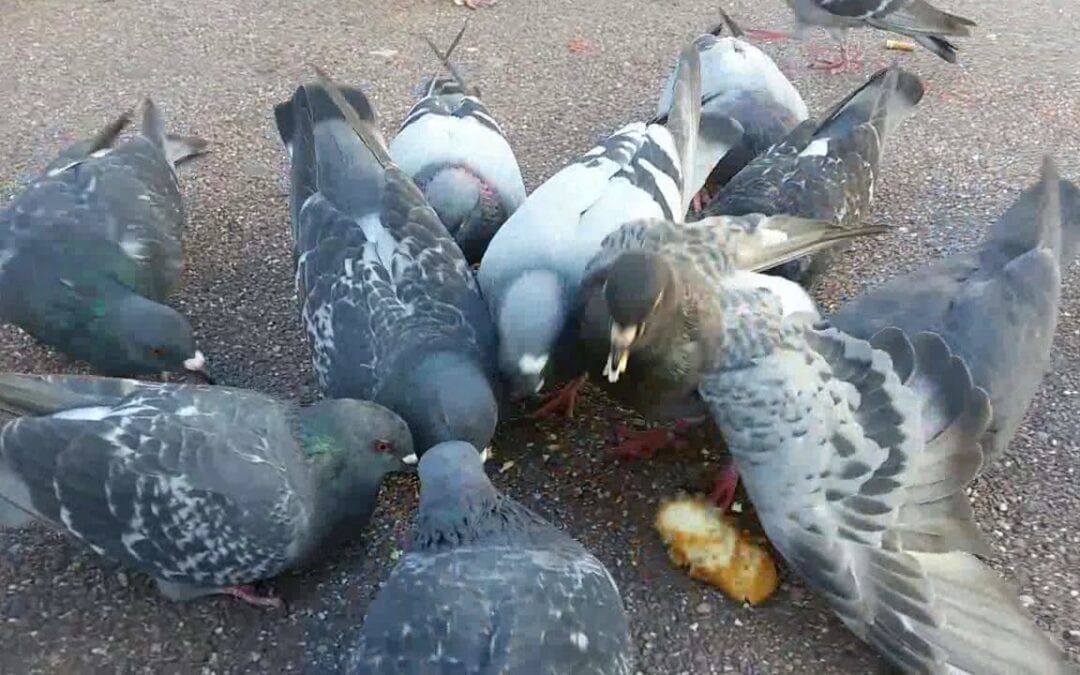
by Pigeon Patrol | Feb 22, 2022 | Bird Spike, Pigeon Patrol's Services, Pigeon Predators, Pigeon Spikes, Pigeons, Pigeons in the News
In his native Iran, Edwin Alexanderian said, pigeons are considered pets.
So about seven years ago, after seeing poisoned pigeons around his home in Brookline and along the street, Alexanderian decided to catch some of the birds and try to nurse them back to health.
When he’s successful, Alexanderian said, he releases the birds where he found them. If a pigeon does not recover completely, Alexanderian keeps it in a coop in his backyard. He now has about 80 pigeons.
“I decided to keep them because I don’t want to put them down,’’ he said.
But Alexanderian’s efforts to help the birds – which typically are poisoned in an effort to control the local population – are getting him in trouble with town officials. He was cited by the town because he never obtained a special permit for the shed-sized coop in his backyard. He’s also been warned by Brookline health officials that he doesn’t have the proper permit to keep the birds.
Health officials say neighbors have complained about a flock of pigeons hanging around Alexanderian’s Hammond Street home and defecating on neighboring rooftops.
“There is no other neighborhood that we have this going on,’’ said Pat Maloney, Brookline’s chief environmental health inspector.
Thomas French, assistant director of the state Division of Fisheries and Wildlife, said there is a chance that the pigeons being kept in a coop could attract other birds.
“They could be coming to visit,’’ French said. “That is a possibility.’’
But if a flock of pigeons are visiting Alexanderian’s coop, he said, they were probably already in the neighborhood and had not traveled a great distance.
Alexanderian, who is president of the Town Meeting Member Association in Brookline, said the pigeons flying around his neighborhood are not his birds, and blames the flock’s size on rat poison that was set out in the area and that has led to the deaths of most of the local hawks. Without the hawks, Alexanderian said, the pigeons have no predators to keep their numbers down.
Alexanderian said his pigeons are in his coop, and the reason he keeps so many of the birds is because once they’ve been poisoned, many are unable to fly long distances.
“They don’t die right away, it affects their brains,’’ Alexanderian said.
French said some poisons used on pigeons have neurological effects that make the birds act strangely and scare off other pigeons. He said MassWildlife issues permits for poisons to be used in an effort to keep pigeon populations at acceptable levels.
“I’ve never heard of anyone trying to intervene and save these birds,’’ French said.
But unless he can obtain the proper permits from the town, Alexanderian may not be able to rescue poisoned birds much longer.
Brookline’s zoning bylaws require that his pigeon coop be kept at least 100 feet away from neighboring properties, said Polly Selkoe, the town’s assistant director of regulatory planning.
Selkoe said Alexanderian’s property “is not really big enough to meet that’’ requirement, and he will need a special permit. Alexanderian said the building commission has already cited him for the coop, and he’s trying to obtain the special permit from the Zoning Board of Appeals.
Selkoe said Alexanderian’s hearing is Dec. 17. If he does get a special permit, Alexanderian would still need a permit from the town’s Board of Health to keep pigeons on his property, Maloney said.
While no one else in Brookline has a permit to keep pigeons, Maloney said, there are a handful of permits that have been issued for other animals, such as chickens, ducks and potbellied pigs.
Alexanderian said that he will fight to keep the pigeons, but if the town tells him he can’t keep them any more, he will release them.
“You think they got a problem now,’’ he said. “Wait until I release my sick birds.’’
Source
Pigeon Patrol Products & Services is the leading manufacturer and distributor of bird deterrent (control) products in Canada. Pigeon Patrol products have solved pest bird problems in industrial, commercial, and residential settings since 2000, by using safe and humane bird deterrents with only bird and animal friendly solutions. At Pigeon Patrol, we manufacture and offer a variety of bird deterrents, ranging from Ultra-flex Bird Spikes with UV protection, Bird Netting, 4-S Bird Gel and the best Ultrasonic and audible sound devices on the market today.
Voted Best Canadian wholesaler for Bird Deterrent products ten years in a row.
Contact us at 1- 877– 4– NO-BIRD, (604) 585-9279 or visit our website at www.pigeonpatrol.ca
Pigeon/Pigeon Patrol / Pigeons Roosting / Vancouver Pigeon Control /Bird Spikes / Bird Control / Bird Deterrent / Pigeon Deterrent? Surrey Pigeon Control / Pest /Seagull deterrent / Vancouver Pigeon Blog / Birds Inside Home / Pigeons in the cities / Ice Pigeons/ What to do about pigeons/ sparrows , Damage by Sparrows, How To Keep Raccoons Away, Why Are Raccoons Considered Pests/ De-fence / Pigeon Nesting/ Bird Droppings / Pigeon Dropping/ woodpecker control/ Professional Bird Control Company/ Keep The Birds Away/ Birds/rats/ seagull/pigeon/woodpecker/ dove/sparrow/pidgeon control/pidgeon problem/ pidgeon control/flying rats/ pigeon Problems/ bird netting/bird gel/bird spray/bird nails/ bird guard
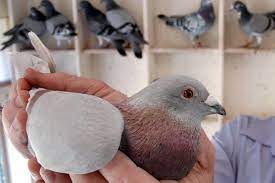
by Pigeon Patrol | Feb 22, 2022 | history of pigeons, MBCA, pet bird, Pigeon Control, Pigeon Droppings, Pigeon Patrol's Services
Pirates, predators, power lines and poor luck — they brave it all for hundreds of miles, while carrying along the million-dollar hopes of the haves and have-nots. Pigeons are the new thoroughbreds in China and everyone has taken notice — breeders in Europe and even the feed industry in the United States.
Pigeon racing goes back hundreds of years and probably a lot longer. The races are held in countries across the globe, but the sport is at fever pitch in China. From Vice: “Twenty years ago — sort of a poor man’s delicacy, but now with the new Chinese economy, it’s become a rich man’s play thing.”
China’s nouveau riche love designer handbags, the finest wine, and sleek cars — but they’re also quick to slap down bags of cash on a pigeon. Money is swirling around Chinese pigeon racing, and the torrent shows no signs of abatement. In 2011, a Chinese entrepreneur payed $200,000 for a pigeon — Blue Prince — at PiPa, the world’s premier pigeon auction house located in Belgium. PiPa sold 218 pigeons that day — for an astounding $1.8 million.
And in 2013, PiPa sold Bolt (named after Olympic sprinter Usain Bolt) to another Chinese businessman for $400,000. An entire lot of 530 Belgian-bred pigeons went for almost $6 million that day, with nine of the 10 most expensive birds headed to China or Taiwan. (In 2009, The Telegraph reported that Chinese mafia gangs were hitting Belgian pigeon coops and stealing the prized birds. “Rather than attempting to smuggle their prey abroad, criminals will kill the pigeons and cut of their identifying rings to be used on much less valuable birds bred in Asia.”)
Blue Prince, Bolt and the other auction birds weren’t bought to race; they are strictly for breeding. As PiPa’s Ya Minna told The Independent, “A pigeon is a far better investment than a fine bottle of vintage wine. You can breed it; it will have children and grandchildren.”
Pigeons may look ordinary, but the actual races are a subculture of chaos. With entry fees ranging from a $200-$1,000, several thousand birds are loaded onto a communal truck and the trek to the starting line begins. The winner will not be the first pigeon to return. The birds are all banded with GPS locators and when they arrive home at their individual coops, a scanner records the arrival time and the winner is determined according to which pigeon flew home at the highest average speed. (This is a sport tailor-made for hijinks and corruption.)

The long haul home
The truck may drive 500-700 miles away, and then the birds are released as the marathon begins. Pigeon pirates are on alert, hoping to catch returning birds to sell on the black market; hawks are always on the prowl; bad weather may claim birds; and disorientation may be a factor.
This is no horse race with a two-minute hurtle towards euphoria or dejection; it’s a dry-mouth game of patience for the pigeon owners and bettors. The wait will last hours; and depending on whether it gets dark and the pigeons roost, it may lapse into the next day.
When the birds arrive home (the strongest birds will fly 600 miles without stopping), the tabulations are made, and the results are announced over the Internet and text. The winners gloat and count their cash; the losers lick their wounds; and the breeding begins.
With the glut of cash in Chinese pigeon racing, the U.S. feed industry has taken note. Jos Zamzow, Meridian, Idaho, believes his family company, Dynamite Marketing, has perfected a high-performance pigeon feed. The News Tribune reports that Zamzow’s first test shipments of the feed concoction will arrive in Taiwan this summer. “After they start winning races, we expect there will be significant demand … pigeon racing is popular all over Asia.”
Zamzow already markets pet and pork feed in Taiwan. “Now Zamzow is betting that Dynamite can transform Idaho-grown safflower and corn — and a top-secret, blood-boosting brew of mushroom powder and yeast cell wall extract it makes in its 102-year-old feed mill — into an annual export business worth up to $15 million.”
Spiraling pigeon auction prices, criminal bird gangs, and a mad gambling boom — a fitting backdrop for a capitalist sport once banned by Chairman Mao.
Source
Pigeon Patrol Products & Services is the leading manufacturer and distributor of bird deterrent (control) products in Canada. Pigeon Patrol products have solved pest bird problems in industrial, commercial, and residential settings since 2000, by using safe and humane bird deterrents with only bird and animal friendly solutions. At Pigeon Patrol, we manufacture and offer a variety of bird deterrents, ranging from Ultra-flex Bird Spikes with UV protection, Bird Netting, 4-S Bird Gel and the best Ultrasonic and audible sound devices on the market today.
Voted Best Canadian wholesaler for Bird Deterrent products ten years in a row.
Contact us at 1- 877– 4– NO-BIRD, (604) 585-9279 or visit our website at www.pigeonpatrol.ca
Pigeon/Pigeon Patrol / Pigeons Roosting / Vancouver Pigeon Control /Bird Spikes / Bird Control / Bird Deterrent / Pigeon Deterrent? Surrey Pigeon Control / Pest /Seagull deterrent / Vancouver Pigeon Blog / Birds Inside Home / Pigeons in the cities / Ice Pigeons/ What to do about pigeons/ sparrows , Damage by Sparrows, How To Keep Raccoons Away, Why Are Raccoons Considered Pests/ De-fence / Pigeon Nesting/ Bird Droppings / Pigeon Dropping/ woodpecker control/ Professional Bird Control Company/ Keep The Birds Away/ Birds/rats/ seagull/pigeon/woodpecker/ dove/sparrow/pidgeon control/pidgeon problem/ pidgeon control/flying rats/ pigeon Problems/ bird netting/bird gel/bird spray/bird nails/ bird guard
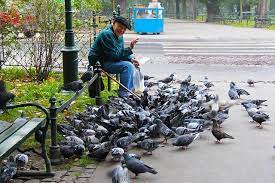
by Pigeon Patrol | Feb 22, 2022 | Bird Spike, Pigeon Spikes, Pigeons, Pigeons in the News, Raccoons, Sparrows, UltraSonic Bird Control
There are over sixty bacterial diseases, viruses, funguses and parasites associated with pigeons. The most problematic for humans would be Histoplasmosis and Cryptococcus. In addition there are: Trichomonisasis, Encephalitis, Meningitis, Pasteurellosis, Blastomycosis, Sarcosporidiosias, Toxoplasmosis, Candidiasis, Lisreiosis, Vibriosis, Salmonella and Paratyphoid. The National Institute of Health has reported a potentially blinding eye condition that probably results from the fungus. In some areas such as parts of Illinois, up to 80% of the population is reported to have been infected at some point.

According to the Washington State DFW, pigeons are excluded from the Migratory Bird Act:
Their nests, eggs, young, and/or adults may be removed or destroyed at any time. No permit is required.
And generally what you find about pigeons indicates they are most often treated as a pest and so you have exterminators and wildlife removal services dealing with them. Trapping is probably fine, but of course any type of shooting in an urban area will be a no-no.
Source\
Pigeon Patrol Products & Services is the leading manufacturer and distributor of bird deterrent (control) products in Canada. Pigeon Patrol products have solved pest bird problems in industrial, commercial, and residential settings since 2000, by using safe and humane bird deterrents with only bird and animal friendly solutions. At Pigeon Patrol, we manufacture and offer a variety of bird deterrents, ranging from Ultra-flex Bird Spikes with UV protection, Bird Netting, 4-S Bird Gel and the best Ultrasonic and audible sound devices on the market today.
Voted Best Canadian wholesaler for Bird Deterrent products ten years in a row.
Contact us at 1- 877– 4– NO-BIRD, (604) 585-9279 or visit our website at www.pigeonpatrol.ca
Pigeon/Pigeon Patrol / Pigeons Roosting / Vancouver Pigeon Control /Bird Spikes / Bird Control / Bird Deterrent / Pigeon Deterrent? Surrey Pigeon Control / Pest /Seagull deterrent / Vancouver Pigeon Blog / Birds Inside Home / Pigeons in the cities / Ice Pigeons/ What to do about pigeons/ sparrows , Damage by Sparrows, How To Keep Raccoons Away, Why Are Raccoons Considered Pests/ De-fence / Pigeon Nesting/ Bird Droppings / Pigeon Dropping/ woodpecker control/ Professional Bird Control Company/ Keep The Birds Away/ Birds/rats/ seagull/pigeon/woodpecker/ dove/sparrow/pidgeon control/pidgeon problem/ pidgeon control/flying rats/ pigeon Problems/ bird netting/bird gel/bird spray/bird nails/ bird guard
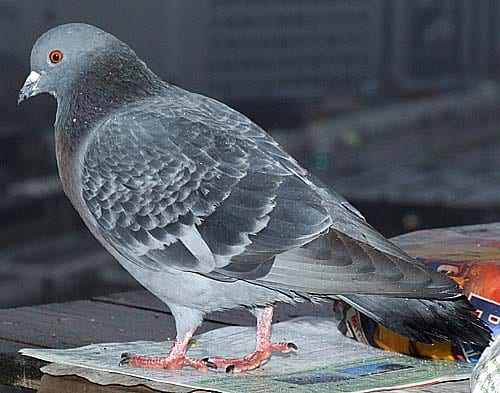
by Pigeon Patrol | Feb 22, 2022 | 4-S Gel Bird repellent, Animal Deterrent Products, Bird Deterrent Products, Bird Law, Bird Netting
Anyone who has lived in an urban environment has seen stringfoot pigeons; many wonder how the feet of these birds come to be bound and twisted, but few people seem to realize that something can be done to alleviate the suffering of these beautiful birds. Although I am a recent arrival to the world of destringing pigeons, this practice is certainly not a new phenomenon. The most perfunctory online search reveals a variety of stories from at least the last few decades of individuals who undertake pigeon destringing, and there are undoubtedly countless other individuals whose destringing activities have gone completely unnoticed and unheralded.
Not long ago I came across the intriguing case of British author and critic Naomi Lewis, noted for her animal advocacy and her pigeon rescue efforts. It isn’t clear precisely when her pigeon destringing efforts started. She moved with her family to London’s Red Lion Square in 1935 and lived there until her death in 2009; her apartment became a haven for injured creatures and famously off limits to visitors, although “she was once observed releasing a convalescent pigeon from one of the windows.”[i]An article from the London Times in 1995 commented on the plight of stringfoot pigeons in the city, and on Lewis’ activities — when the article was written, Lewis was already in her 80s: “The writer Naomi Lewis goes round London with a small pair of scissors especially to help them. She has become expert at spotting pigeons in this plight, pouncing on them, picking them up, and cutting them free.”[ii]More recently, an author once acquainted with Lewis noted her passion for rescuing stringfoot pigeons: “Luckily for them, she knew where they were. During her hours of cycling around and wandering the streets, distributing bird seed, she had learned where the crippled ones lived. Imagine her patience – the endless searching, trudging, scattering, waiting, day after day, until she eventually caught them.”[iii]The image of Lewis, an elderly, “diminutive, velvet-clad woman,”[iv]bicycling and trudging about London in search of stringfoot pigeons is compelling and inspiring. Perhaps part of what draws me to the story of Lewis is that articles that mention her (including her obituaries) suggest, in the nicest way possible, that she was quite an eccentric, and her attraction to urban pigeons seems to be one of the factors that contributed to this assessment of her character. We who love pigeons are keenly aware that this love is often equated with eccentricity.
Judging by the reactions I have seen among people on the street who witness the process of pigeon destringing, it is an activity generally perceived as eccentric, and at first the reasons it is needed and done are difficult for observers to grasp. But once these somewhat confused and often skeptical bystanders understand what is going on and why, they are just as often supportive of efforts on behalf of pigeons and some are even anxious to participate. The evidence before their eyes helps to convince observers of both the beauty of these birds and our responsibility to help them. The destringing of urban pigeons can be seen as much more, therefore, than simply an effort to assist wild creatures to have lives free of suffering. It is one more way that we pigeon champions can help to normalize the public perception of all pigeons as valued and valuable creatures.
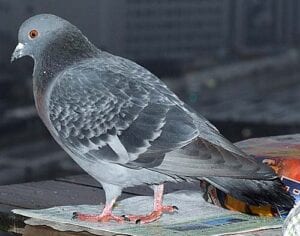
The Destringing Process in Action
What is the experience of destringing a pigeon like, and how is it done? There are many others who have been destringing for years, have handled countless stringfoot pigeons, and are so much more well-qualified than I to discuss this experience. With apologies, therefore, for my inexperience, I’d like to recount one of my own destringing experiences in San Francisco as a way of introducing the destringing process in general.
- Finding a stringfoot pigeon
Last week, a Muni failure forced me off the train at Church and Duboce. I had my destringing kit with me; I was headed for the Embarcadero, where there is a large population of stringfoot pigeons. Walking towards Market Street, I passed the Safeway parking lot and caught a glimpse of a pigeon flock there, browsing, preening, and flirting. Just in case, I stopped to check on them — and immediately spotted a beautiful white and grey girl with string on her feet, her feet bound together, barely able to walk.
- Catching the stringfoot pigeon
A crucial aspect of the destringing process is, of course, catching the pigeon. This is an acquired skill (one I am still working on), that requires much practice and patience. For those living in cities that are fortunate enough to have Stringfoot Pigeon groups, one of the best ways to learn how to catch pigeons is one-on-one expert coaching. Destringers seem to each develop their own approach to catching birds. For myself, I find that the position and disposition of the pigeon are the most important factors. I have the greatest likelihood of success if the pigeon is facing towards me (can’t easily fly away); is hemmed in by other birds; and has shifted its attention from me to the food I am dropping. After three tries and almost giving up all hope, I managed to catch this white and grey stringfoot girl.
- Destringing
The actual destringing can range from a simple process, when the string or hair is easy to see, loosely wound, and easily removed, to a monumental challenge when the material is voluminous, woven in complex layers, deeply embedded in the foot, or has already caused a lot of tissue damage and deformity. Although each case is very different, at the most basic level the process involves spraying the foot with something like Vetricyn to clean, loosen, and soften the fibers, dirt, and any dead tissue; and then very gently loosening, cutting, and unwinding fibers from the foot. Unwinding when possible instead of simply cutting helps to ensure that no hair or thread remains embedded in the skin. Fortunately for me and for this pretty pigeon, her string — which looked like a combination of twine and dental floss — was easy to see and remove, although cutting into her foot quite deeply.
- Releasing the pigeon
Of course, once the pigeon’s feet are free and disinfected, the pigeon should be released back where caught and, if possible, in sight of her flock, who she will want to join quickly in order to recount her unpleasant adventure.
- Why we do it, when we shouldn’t, and how you can help
One of the factors that motivates me to destring stringfoot pigeons seems so self-evident that it almost goes without saying: these pigeons cannot remove string from their own feet. If you take a moment to really consider this simple fact, however, the enormity of it can be overwhelming. To realize this fact is to accept the knowledge that each and every stringfoot pigeon will live their entire lives in ever-increasing pain, acquiring infections, losing digits and feet, and becoming unable to perform the basic activities required to live, unless a human sees their need, picks them up, and frees their feet.
Alongside the recognition of this need, destringers also have to realize their own limitations. Even in the brief time I have been destringing, I have seen heartbreaking examples of pigeons with deformed and painful stringfeet who I simply could not catch. The numerous destringers who have more experience than I must have countless such stories. Jodie Foreman, who started the “San Francisco Pigeons – Stringfoot help” group and several groups in other US cities, told me that when she is out but does not have her destringing kit with her, she tries to resist looking at pigeons (I believe she now carries her kit at all times!). Although it is hard to resist, there is no advantage to catching a stringfoot pigeon if one is unprepared to destring, and destringers advocate against removing any pigeon from its flock, its mate, and possibly its babies.
There are many resources available for anyone interested in helping to free the feet of these beautiful birds. The facebook group “San Francisco Pigeons – Stringfoot help” (and groups in Denver, Chicago, Washington, Seattle, and Los Angeles) provides a wealth of information about finding, catching, destringing, and the complex issues that can arise in the destringing process. Experienced destringers on these forums give generously of their time to answer questions, give advice, and provide training.
There are few forms of wildlife rescue that demand as little from the rescuer as destringing stringfoot pigeons. If you are willing to do some research, buy a handful of supplies, and you have a bit of time, you can doubtless find stringfoot pigeons in need of help near you, regardless of where you are. And it is difficult to imagine another rescue activity that can provide the same level of instantly transformative relief from pain and disability, and lasting impact on quality of life, as freeing the feet of these gentle and beautiful creatures.
Source
Pigeon Patrol Products & Services is the leading manufacturer and distributor of bird deterrent (control) products in Canada. Pigeon Patrol products have solved pest bird problems in industrial, commercial, and residential settings since 2000, by using safe and humane bird deterrents with only bird and animal friendly solutions. At Pigeon Patrol, we manufacture and offer a variety of bird deterrents, ranging from Ultra-flex Bird Spikes with UV protection, Bird Netting, 4-S Bird Gel and the best Ultrasonic and audible sound devices on the market today.
Voted Best Canadian wholesaler for Bird Deterrent products ten years in a row.
Contact us at 1- 877– 4– NO-BIRD, (604) 585-9279 or visit our website at www.pigeonpatrol.ca
Pigeon/Pigeon Patrol / Pigeons Roosting / Vancouver Pigeon Control /Bird Spikes / Bird Control / Bird Deterrent / Pigeon Deterrent? Surrey Pigeon Control / Pest /Seagull deterrent / Vancouver Pigeon Blog / Birds Inside Home / Pigeons in the cities / Ice Pigeons/ What to do about pigeons/ sparrows , Damage by Sparrows, How To Keep Raccoons Away, Why Are Raccoons Considered Pests/ De-fence / Pigeon Nesting/ Bird Droppings / Pigeon Dropping/ woodpecker control/ Professional Bird Control Company/ Keep The Birds Away/ Birds/rats/ seagull/pigeon/woodpecker/ dove/sparrow/pidgeon control/pidgeon problem/ pidgeon control/flying rats/ pigeon Problems/ bird netting/bird gel/bird spray/bird nails/ bird guard
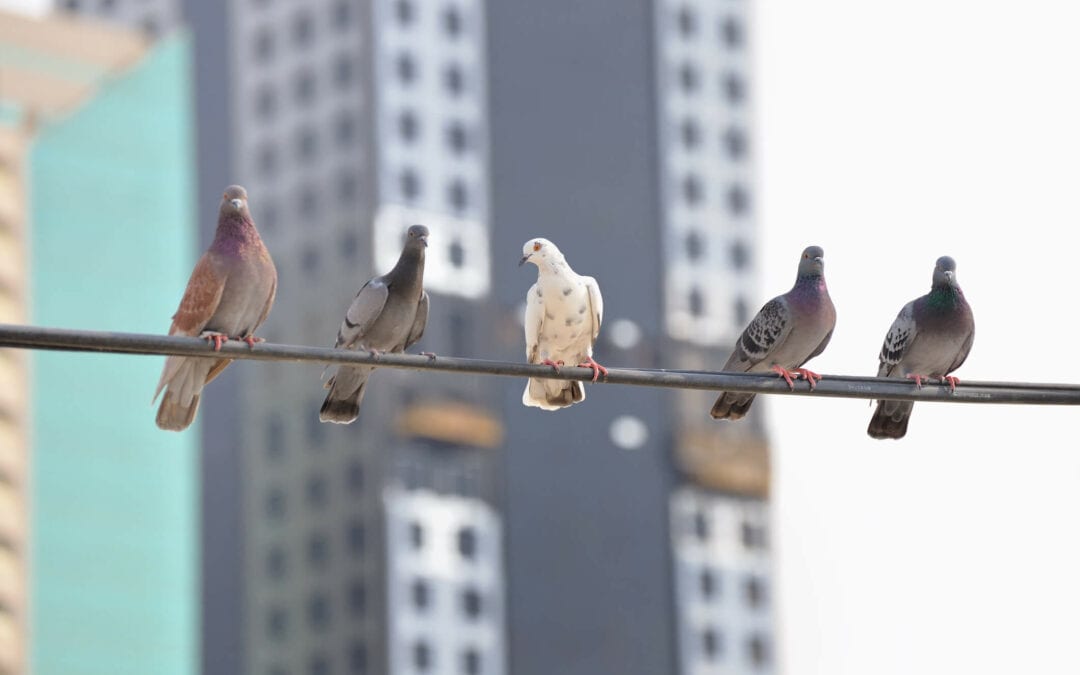
by Pigeon Patrol | Feb 16, 2022 | history of pigeons, MBCA, pet bird, Pigeon Control, Pigeon Droppings, Pigeon Patrol's Services, Pigeon Predators
Every spring, down-covered mallard ducklings follow their mother across a pond. Goslings graze along side their Canada Geese parents in waterfront parks. Baby chickens peck the ground soon after hatching. But why do we never see baby pigeons?
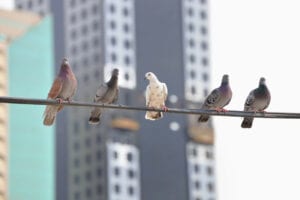
Some baby birds—like those down-covered ducks, geese, and chickens—leave their nest shortly after hatching and do a lot of growing up while following their parents around. Others, like pigeons, stay in the nest and depend on their parents to feed and protect them, well into their youth.
When young Rock Pigeons finally leave the nest, they are full sized with adult feathers, and they look like their parents. So unless you look carefully under a city bridge, you aren’t likely to ever see a baby pigeon.
It’s easy to imagine, when hearing soft cooing sounds like these, why baby pigeons would rather stay in the nest. But the reason is they wait to fledge until they are nearly independent and the task of getting on with life is a bit easier.
Source
Pigeon Patrol Products & Services is the leading manufacturer and distributor of bird deterrent (control) products in Canada. Pigeon Patrol products have solved pest bird problems in industrial, commercial, and residential settings since 2000, by using safe and humane bird deterrents with only bird and animal friendly solutions. At Pigeon Patrol, we manufacture and offer a variety of bird deterrents, ranging from Ultra-flex Bird Spikes with UV protection, Bird Netting, 4-S Bird Gel and the best Ultrasonic and audible sound devices on the market today.
Voted Best Canadian wholesaler for Bird Deterrent products ten years in a row.
Contact us at 1- 877– 4– NO-BIRD, (604) 585-9279 or visit our website at www.pigeonpatrol.ca
Pigeon/Pigeon Patrol / Pigeons Roosting / Vancouver Pigeon Control /Bird Spikes / Bird Control / Bird Deterrent / Pigeon Deterrent? Surrey Pigeon Control / Pest /Seagull deterrent / Vancouver Pigeon Blog / Birds Inside Home / Pigeons in the cities / Ice Pigeons/ What to do about pigeons/ sparrows , Damage by Sparrows, How To Keep Raccoons Away, Why Are Raccoons Considered Pests/ De-fence / Pigeon Nesting/ Bird Droppings / Pigeon Dropping/ woodpecker control/ Professional Bird Control Company/ Keep The Birds Away/ Birds/rats/ seagull/pigeon/woodpecker/ dove/sparrow/pidgeon control/pidgeon problem/ pidgeon control/flying rats/ pigeon Problems/ bird netting/bird gel/bird spray/bird nails/ bird guard

by Pigeon Patrol | Feb 16, 2022 | Bird Spikes, Columbidae, Doves, history of pigeons, MBCA, pet bird, Pigeon Control
It’s no secret big cities have pigeon problems. Toronto is no exception. Like rats in the middle ages, the disease-carrying vermin spent the past decade running amok and increasing their numbers. It was my job to try and keep Toronto’s ever-growing pigeon population in check. Thankfully, I came across an article about a pilot project where researchers replaced pigeon eggs with wooden substitutes. The birds, too stupid to know the difference, spent months caring for the fake eggs instead of producing more. The project was a huge success, and the pigeon population decreased significantly in a short amount of time. It sounded like the perfect plan, so I implemented the solution in my city.
What I didn’t count on was for those fake eggs to hatch, and for the abominations inside to be released into the world.

Clint, my partner, came in one morning carrying a large wooden crate with straw poking out of every crevice.
“Looks like Christmas came early this year,” he said, “What is this stuff?”
I excitedly walked over, helping him set the box down on a workbench.
“This,” I said, prying it open to reveal its contents, “is the solution to our pigeon problem.”
Reaching inside, I took one of the eggs. I was a little disappointed to see that they weren’t wooden, as promised. Instead, they were thin, light, and hollow like those cheap plastic Easter eggs. It wasn’t close to what I was expecting.
Oh well, that’s what you get for ordering off of Ebay, I thought.
Clint took a handful of the eggs.
“These are the replicas you ordered? They don’t feel remotely the same as the real deal.”
We were well aware of what the eggs felt like. Up until then, the only way to decrease the pigeon population was to sneak into their nests and steal the eggs. It was a futile, temporary solution, because the birds would just lay new eggs once they realized theirs were gone. That’s what made the idea of using substitutes so damn good.
“It’s fine, Clint. They don’t have to fool us, they just have to fool the pigeons. This’ll work, trust me,” I answered.
I was right: the pigeons fell for it, hook, line, and sinker.
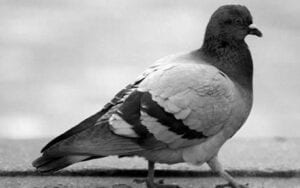

A few months passed, and we started seeing a decline in the amount of younger birds in the area. I can’t tell you how proud I was of what I’d done. I’d found a safe, environmentally friendly way of dealing with the flying rats, at the cheap cost of a few hundred dollars and an elevator trip to pigeon nesting grounds atop high-rise rooftops around the city.
The problems started about three months in. Clint and I were inspecting nests on opposite sides of the city. I was halfway up the building when Clint called me.
“Yo,” I answered.
The sound of wind could be heard in the background. Evidently, Clint had reached his destination.
“Hey. Some of our eggs broke,” he announced.
The elevator came to a stop, doors swinging open to let me off. I stepped out and made my way to a small staircase leading to the rooftop.
“We’ll just have to replace them. No big deal,” I answered nonchalantly.
There had been a few violent storms since our last inspection, and I figured the eggs must have fallen from the nests and shattered on impact. See, this is why wood would have been better, I grumbled to myself, as I exited onto the rooftop for my inspection.
“Well, fuck,” I said.
“What?” answered Clint.
Most of my eggs were broken, too. The strange thing was that they were still tucked in the nests, right were we’d left them. Had the pigeons figured out our ploy and attacked the replicas? Were the fake eggs too frail to survive our harsh Canadian weather?
I groaned.
“It’s the same here. We’re going to have to start over,” I told him, defeated.
Clint laughed.
“It’s all good, we can hatch a new plan.”
I paused for a moment.
“Did you just-” I began, but he interrupted.
“Just look on the sunny side up of things, yeah?”
Puns. At a time like this. Puns.
“Don’t yolk with me,” I replied, with a sigh.

We couldn’t leave the nests unattended for too long, otherwise all our progress would go down the drain. I sent Clint to replace the broken eggs with what was left from our original order. In the meantime, I searched online for anyone selling wooden eggs. Unfortunately, the cheapest – and fastest shipper – was the person we’d ordered from the first time around. We needed these eggs quickly, and our budget was pretty tight. I figured I’d order the subpar eggs one more time. If they lasted long enough for city officials to see the plan was working nicely, I was sure I could convince them to increase our budget so we could order better supplies next fiscal year.
Just to be sure the pigeons weren’t attacking our fake eggs, I also set up a security camera on one of the rooftops. I needed to know if they’d gotten wise to our ruse, though I highly doubted they had the mental capacity to do so. Still, the project would prove fruitless if the birds weren’t fooled by our cheap imitations, so it was best to keep an eye out.

Over the course of the following weeks, I started getting strange reports about small animals behaving in a bizarre manner. Frankly, I didn’t pay much attention to them, at first. They sounded a little insane, to tell the truth. One woman claimed she’d seen a pigeon climb a tree. She said he crawled up the bark like a squirrel. Another report stated that a chipmunk had been seen attacking – and killing – a neighborhood dog. Another witness called in about an injured cat, but when he investigated, all he found was a pelt.
By the time I read the fifth report, I was starting to get a little worried. What was even more troubling to me was that these reports were coming from all over the city. If it had been confined to a single neighborhood, I would have suspected an outbreak of rabies, or a new disease of some sort. But the reports were coming in from all around Toronto and its suburbs, which span an extremely large area. How could anything spread so quickly? It had to be something else.
I was just about to do a bit of research on the subject when Clint came in, wearing a scowl.
“Broke. Shitty fucking eggs broke again,” he grumbled, throwing himself on his chair.
I forced a grin.
“Crack a smile, would ya?”
He tossed his worksheet on the table.
“That was an egg-cellent pun,” he replied, releasing a single chuckle.
“You remember to bring the footage?” I asked him.
He unzipped his coat and reached into his pocket for an SD card, “Gotcha covered. Movie time!” he chirped.
We uploaded the footage and took a look.

Pigeons.
Pigeons sitting on their nests.
Pigeons preening.
Pigeons flapping their wings at one another.
A squirrel.
A squirrel getting chased away by birds.
More pigeons.
It must have been the dullest security tape in the world. The kind of footage that even David Attenborough’s lovely voice wouldn’t be able to save. We fast-forwarded through days of pigeons doing pigeon-y things. Never once did they show any violence towards our replica eggs.
Clint had dozed off by the time something finally happened on-screen. The only reason I was still conscious was due to the copious amount of coffee I’d ingested that morning.
It was dead of night. In the video, at least. One of the birds flew off its egg and perched itself on the nest, peering inside. This is it, I thought, leaning closer to the screen. I figured he’d attack the egg, but I was wrong.
I watched as the video soundlessly continued, and something cracked open the egg – from the inside. My jaw gaped open. This wasn’t possible: the eggs were plastic shells. The only explanation was that we’d missed one real egg somewhere in the bunch. Yeah, that had to be it. I was witnessing the birth of a baby pigeon, nothing weird.
Except baby pigeons don’t look like smoke.
A puff of dark air came out of the egg. The pigeon, head inches from it, inhaled the gassy substance. It reared back and stood completely still for about a minute, before falling over. I watched as it started thrashing violently, like it was having a seizure. Then, from its beak spewed some kind of chunky liquid that evaporated as soon as it hit the air. The pigeon’s body seemed to deflate like a balloon, as though the creature was being hollowed out. I was left staring incredulously at the flat, immobile husk of what had once been a pigeon.
Suddenly, the pigeon’s chest bulged out and the animal regained its form. At least, sort of. Its proportions were all wrong: its wings were bloated and angled oddly, most of its girth was in its neck rather than stomach, and its midsection had stretched out unnaturally. It was like looking at an animal pelt draped over the wrong mound. Like a lunatic taxidermist’s cruel experiment. The abomination of nature jerked its head towards the ledge. It twisted onto his back, legs contorting and dislocating in such a way as to be able to reach the ground. From its throat, I could see stump-like arms stretching out, clawing at the cement rooftop. In quick and jagged movements, the creature skittered over the edge, and disappeared from view.
I was shocked, unable to believe what I had seen. I had to watch and re-watch the video several times, before it occurred to me to wake Clint up. He grumbled unhappily, rubbed his tired eyes, and looked at me.
“You won’t believe this,” I uttered.
I rewound the footage and pressed play. His eyes widened with the same disgusted disbelief as mine. Even on my fifth viewing, I couldn’t wrap my head around it.
“This is bad,” he said.
“… I know,” I answered.

After watching the video a few more times, we went home. I think we both hoped a good night’s sleep would help clear our minds. Maybe, upon reviewing the tape, we’d realize we were mistaken. Maybe it was a trick of the light? Unlikely, but we could only hope.
Clint was already at work when I came in. His eyes were glued to the screen.
“Watching it again?” I asked.
“Not exactly,” he replied, “… I … kept going.”
I approached the desk and peered at the monitor.
“Kept going?” I questioned.
His face was pale and his eyes weighed down by large bags. How long had he been here? Had he come in extra early?
“There was two days left of footage on the card,” he explained.
“And you went through it?”
“Yeah…”
“Did you see…more of those things?”
Clint pressed his lips together, “Yeah…and…some of them came back,” he explained.
I raised my eyebrows, looking closer at the screen. I noticed something odd about one of the nests. There were multiple eggs resting in the sunlight. They were neither genuine pigeon eggs, nor replicas. They were too big for that.
Clint pointed to the batch, his hand trembling.
“It laid them,” he murmured.
I felt a flush of nervous energy climb up my spine like an elevator, and then turned to the reports I’d been reading the day before. Were the eggs at the center of it all?
“We need to call the authorities,” I uttered shakily.
“We ARE the authorities,” he replied, his voice sounding frantic.
I paced around the room. Back and forth, back and forth, like a pendulum.
“It laid them.”
The phone rang, interrupting my anxious march. It was another report of odd animal behavior. This time, the culprit was a deer. In a spooked and almost disgusted tone of voice, the woman on the line explained that she’d seen a deer slithering along the river. She said its body was sideways, but its head was upright. Oh god, I thought. What ever those things were, they could affect larger animals. While I tried to comfort the worried caller, I heard something from Clint’s workstation.
Crack
I turned around, only to see a puff of smoke rising towards my coworker. Near his keyboard was a cracked shell, just like the ones on the rooftop. Without a word, Clint bolted to the bathroom, holding a hand over his mouth as though about to puke. I dropped the phone and ran over to the door. It was locked.
“Clint … are you okay?”
Silence.
Silence.
Silence.
All of a sudden, I heard him heaving violently. A sound of moist gurgling and boiling water erupted from the bathroom. Terrified of what would happen if Clint got out, I pushed the heavy workbench in front of the door. I stood in terrified silence as the noise came to a stop. Was Clint now lying as flat as a pancake against the porcelain throne? Would it turn into some sort of bastardization of a human body, like what happened to the pigeon?
Silence.
Silence.
Silence.
BANG
Clint threw himself against the door violently. Just one blow nearly threw the thing off its hinges. Again and again, he slammed himself against the surface, causing the workbench I’d placed in front of it to slowly inch away. All I could do was push myself against it to try and keep the door closed. My only thoughts were to keep him from escaping, for my own safety. I knew he’d attack me if I let him out. I just knew it.
The sound came to an unexpected halt, allowing me to breathe a sign of relief. Maybe he’d expired. Maybe that thingneeded fresh air to survive. Whatever the reason, I thought I was safe.
But then, I heard a crash. The window. I’d forgotten all about the bathroom window.
He’s out there now. Him, and those other mutated atrocities. I don’t know what they are or what they want. All I know is that they’re roaming the city right now, doing god knows what. Most of them probably look like pigeons, but they can be anyone or anything. I just hope someone figures out how to stop them because, at last count, there were over 700 of those cursed eggs planted around Toronto. Now that I know these things can reproduce, god knows how many more eggs might be out there.

Update 1:
He came back…
I should have known he’d come back.
He warned me before: he said the creatures on our recording returned to its nest to lay their eggs. Those monsters seemed to have the salmon mentality: going back to their place of birth when it came time to reproduce.
Too busy answering a slew of panicked calls – all the while panicking myself – I didn’t hear him when he came in through the front door. Thankfully, I caught a shape from the corner of my eyes. Without even finishing my sentence, I dropped the phone and locked myself in the maintenance closet, praying he hadn’t seen me.
Outside the thin wooden door, the room was quiet.
If he was breathing, I couldn’t hear it. His footsteps were just as silent. Had I overreacted? I hadn’t actually seen Clint, just a shadow in my peripheral vision. Maybe it was my imagination. I needed to know, so I knelt down, peered through the crack under the door, and closed an eye to get a better look.
I wish I hadn’t. I wish I could erase that thing from my mind, to preserve Clint’s memory as the man I knew him to be. Not that. Anything but that.
What I saw was a mess of flesh inching along the floor like a slug. I couldn’t figure out what was facing up: his back or his chest. His spineless torso had folded over, bringing his arms nearly perfectly in-line with his legs. His head, now completely shapeless, lay flat at his midsection. His mouth reminded me of the figure in Munch’s famous painting, The Scream. His greyed eyes stared at me, but I could tell, as he continued to slither towards his desk, that they were useless decorations.
He disappeared from view.
Then, came a horrid sound: a squishy and gooey noise that reminded me of the old slime ball toys I used to play with as a child. It lasted a few moments, stopped, started again, and then stopped for good.
Shaking in my boots, I remained concealed in my dark prison all day, ignoring repeated hunger pangs and my own instinct to run. I couldn’t afford the risk of being caught. As day shifted into night, I began to wonder if I could sneak past him. On our security tape, I’d seen normal pigeons sitting on nearby nests, seemingly unfazed by the creature. Maybe Clint wouldn’t attack me. I had to take the chance: I couldn’t hide forever.
As quietly as I could, I swung the door open and stepped into the office. The thing wearing Clint’s skin was gone.
Thank god, I thought.
Out of morbid curiosity, I glanced at his workstation, where I’d heard the unsettling noises earlier. There were two massive eggs sitting on his desk, coated in a viscous substance. I didn’t even want to think of the implications. I didn’t want to know out of which orifice he’d laid them. I wanted nothing to do with this anymore.
I ran out of the office, to my car, and drove straight to Kingston.
I’m not going back. I will never go back. Someone else will have to deal with this situation.

Update 2:
I thought I could get away from them, but now, I’m not so sure. Maybe I’m imagining it, but the pigeons outside look … odd. Not as disproportionate and disfigured as what I saw in Toronto, but … there’s something wrong about the way they move.
I think those things are learning to better mimic the shape of what they’re possessing. And now, they’ve spread.
Source
Pigeon Patrol Products & Services is the leading manufacturer and distributor of bird deterrent (control) products in Canada. Pigeon Patrol products have solved pest bird problems in industrial, commercial, and residential settings since 2000, by using safe and humane bird deterrents with only bird and animal friendly solutions. At Pigeon Patrol, we manufacture and offer a variety of bird deterrents, ranging from Ultra-flex Bird Spikes with UV protection, Bird Netting, 4-S Bird Gel and the best Ultrasonic and audible sound devices on the market today.
Voted Best Canadian wholesaler for Bird Deterrent products ten years in a row.
Contact us at 1- 877– 4– NO-BIRD, (604) 585-9279 or visit our website at www.pigeonpatrol.ca
Pigeon/Pigeon Patrol / Pigeons Roosting / Vancouver Pigeon Control /Bird Spikes / Bird Control / Bird Deterrent / Pigeon Deterrent? Surrey Pigeon Control / Pest /Seagull deterrent / Vancouver Pigeon Blog / Birds Inside Home / Pigeons in the cities / Ice Pigeons/ What to do about pigeons/ sparrows , Damage by Sparrows, How To Keep Raccoons Away, Why Are Raccoons Considered Pests/ De-fence / Pigeon Nesting/ Bird Droppings / Pigeon Dropping/ woodpecker control/ Professional Bird Control Company/ Keep The Birds Away/ Birds/rats/ seagull/pigeon/woodpecker/ dove/sparrow/pidgeon control/pidgeon problem/ pidgeon control/flying rats/ pigeon Problems/ bird netting/bird gel/bird spray/bird nails/ bird guard

by Pigeon Patrol | Feb 16, 2022 | history of pigeons, MBCA, pet bird, Pigeon Control, Pigeon Droppings, Pigeon Patrol's Services, Pigeon Predators
Pigeons are beautiful to look at but they can also be a nuisance when they decide to invade your home. The cooing sounds can get loud and they’re known for messing up compounds with bird droppings and feathers. In addition to being annoying, pigeons also carry parasites and spread diseases. They roost in flocks and getting rid of them can be a challenge. Here are a few tips on how to get rid of pigeons without hurting them.
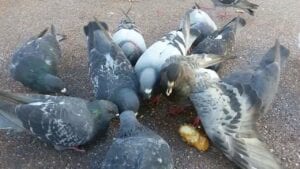
How to Get Rid of Pigeons Without Hurting Them
Pigeons can be a great nuisance, especially when they are in unwanted areas like a garden or under solar panels. Below is a list of a few ways to get rid of pigeons without hurting them.
Make Roosting Spaces Less Appealing
Make the spaces where pigeons land uncomfortably. You can achieve this by installing spike strips where the pigeons like to land. Make their nesting areas more difficult for them to survive by fastening the waterproof stings. This will make it harder for them to balance, forcing them to look for an alternative perching area.
Clean Upkeep
Keeping your surrounding clean is one of the best ways to keep pigeons away from your home. Keeping the grass trimmed low and having the trash picked up regularly will make your home less attractive to pigeons.
Avoid Feeding Them
Never feed pigeons or allow bird feeders to remain on your property. Feed pigeons and they’ll always return to places where they can find food.
Deter Pigeons from Your Roof
Block all exposed nooks and cover them with sturdy metal mesh. Inspect your entire house and seal off any potential entrances where pigeons can make their nests. Pigeons will commonly use chimneys, attics and window air conditioning units. To prevent them from making nests on or in these areas, seal off all entrances with a net.
Scare Off the Pigeons
Pigeons, like most birds, will scare easily. For instance, pressure washing pigeon holes with water will prevent the birds from returning. Alternatively, you can scare them off by placing a plastic owl in the yard, on a tree or close to the spot where they like to perch.
Hang wind chimes, a mirror or other reflecting surface in your garden. The reflection will irritate the pigeons and prevent them from coming back.
Get Rid of The Birdbath
Pigeons need water every day to survive. When there’s no water source, pigeons and insects won’t survive. Bird baths not only attract birds but also rodents and mosquitoes. If you can’t get rid of the birdbath, keep it clean and replace it with fresh water frequently.
Spray Honey Solution
This is one of the simplest yet most effective natural solutions to get rid of pigeons. Take a cup of water and mix it with a cup of honey. Pour the mixture into a spray bottle and spray the solution on areas frequented by the pigeons. Pigeons dislike sticky solutions and will naturally stop coming to your yard.
There are plenty of other tricks on how to get rid of pigeons without hurting them. Once they’re out of your yard, find ways to prevent them from coming back to your premises. The trick is to be consistent in your efforts. For more information, professionals from Pigeon Solutions can help you.
Source
Pigeon Patrol Products & Services is the leading manufacturer and distributor of bird deterrent (control) products in Canada. Pigeon Patrol products have solved pest bird problems in industrial, commercial, and residential settings since 2000, by using safe and humane bird deterrents with only bird and animal friendly solutions. At Pigeon Patrol, we manufacture and offer a variety of bird deterrents, ranging from Ultra-flex Bird Spikes with UV protection, Bird Netting, 4-S Bird Gel and the best Ultrasonic and audible sound devices on the market today.
Voted Best Canadian wholesaler for Bird Deterrent products ten years in a row.
Contact us at 1- 877– 4– NO-BIRD, (604) 585-9279 or visit our website at www.pigeonpatrol.ca
Pigeon/Pigeon Patrol / Pigeons Roosting / Vancouver Pigeon Control /Bird Spikes / Bird Control / Bird Deterrent / Pigeon Deterrent? Surrey Pigeon Control / Pest /Seagull deterrent / Vancouver Pigeon Blog / Birds Inside Home / Pigeons in the cities / Ice Pigeons/ What to do about pigeons/ sparrows , Damage by Sparrows, How To Keep Raccoons Away, Why Are Raccoons Considered Pests/ De-fence / Pigeon Nesting/ Bird Droppings / Pigeon Dropping/ woodpecker control/ Professional Bird Control Company/ Keep The Birds Away/ Birds/rats/ seagull/pigeon/woodpecker/ dove/sparrow/pidgeon control/pidgeon problem/ pidgeon control/flying rats/ pigeon Problems/ bird netting/bird gel/bird spray/bird nails/ bird guard
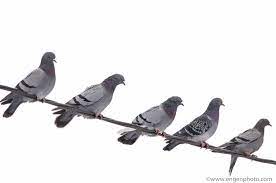
by Pigeon Patrol | Feb 16, 2022 | Bird Spike, Pigeon Droppings, Pigeon Patrol's Services, Pigeon Predators, Pigeon Spikes, Pigeons, Pigeons in the News
How to Get Rid of Pigeons from a Balcony
Getting rid of pigeons from small areas like balconies can be resolved with relatively simple common-sense solutions.
-
Wires. You can use a wire coil or stainless-steel wire to deter pigeons perching on rails.
-
Shock Track. Several suppliers offer a “shock track” system to keep birds off balconies. The shock track does not hurt the bird but provides enough stimulation to make the targeted perching area unattractive.
-
Netting. Consider using a netting system to physically exclude the birds from balconies. This is the costliest alternative, although if installed properly it’s 100% effective. Newer versions of netting are virtually invisible.
-
Sound or reflected light. The easiest way to deter pigeons from your patio, deck, or balcony, is with sound or reflected light. You can achieve this with a wind chime, Mylar balloon, aluminum foil pans or even hanging CD’s. The reflected light disorients the birds.
-
Plastic owl or rubber snake. Consider using scarecrows (“effigies”). The most common example is a plastic owl or rubber snake. Unfortunately, the effects will most likely be short-lived. The pigeons come to recognize the scarecrow as something that is not a threat.
-
Spikes. Consider using anti-perching spikes that you can attach anywhere the birds like to perch. Spikes are best advised for limited areas where the goal is to move the birds someplace else. They are available in different materials from plastic to stainless steel.
-
Gel Repellants. You can use gel repellants to ledges where pigeons perch. The gel makes the surface sticky and the birds will try to avoid it. Unfortunately, dust and debris take their toll and reapplication is often necessary. The application of gel repellants is not recommended where there are smaller birds. They can permanently get stuck in the goo

How to Get Rid of Pigeons from a Roof
Getting rid of pigeons from a residential or commercial roof can be far more challenging. Although some are better than others, all the solutions that apply for keeping pigeons off a balcony (above), can also apply to larger open areas.
-
Consider using a wire coil or stainless-steel wire to deter pigeons from perching on the ridge(s).
-
A “shock track” system might keep birds off rooftops
-
Using wire or netting is appropriate for a roof design that incorporates nooks. You can also apply nets where the pigeons can construct a nest.
-
Solar panels provide excellent harborage for pigeons. Metal grid netting is the most effective method to limit access to the birds.
-
Flat commercial roof styles have their own set of challenges. The first option is to electrify the parapet perching areas. The second option is to install simple spikes. Be aware that pigeons enjoy the comfort of HVAC installations. As a solution, consider netting these units.
How to Get Rid of Pigeons at Industrial Facilities
The basic nature and scope of modern industrial facilities make them highly attractive to pigeons. The design of these facilities is most often open which allows the birds ready ingress and egress. More importantly, pipes, beams, poles, and catwalks offer a wide range of harborage and nesting options. Food sources are typically located nearby and as mobile pests, pigeons can move around freely from one area of the plant to the next.
Pigeons can represent a costly nuisance for plants, and in many cases have been at the facility ever since it was built. Over time, the nests, feces, and debris can cause considerable damage to a plant’s mechanical and electrical components. Furthermore, the birds’ droppings and other debris add additional health hazards to an already hazardous area.
Most conventional methods of pigeon mitigation offer little comfort to an industrial facility and decision makers often select culling solutions since everything else is either prohibitively costly or impractical. Methods such as trapping and poisoning the birds may help alleviate the problem temporarily, however, due to their rapid breeding, pigeons always return and repopulate the very attractive site in a few weeks or months.
While highly effective at smaller sites, physical exclusion is typically not an option at a larger plant. It is simply impossible to cover an oil refinery or power plant with a net.
The more common solutions for smaller scale facilities are only appropriate for the resolution of isolated problems at a larger plant. An area where there is zero tolerance for birds mandates physical exclusion to keep them out, while the overall control strategy needs to focus on abatement.
The following graphic provides an outline of the various options for bird abatement. There are just two alternatives:
-
Increase mortality with the common culling methods, trap, shoot or poison
-
Reduce reproduction with a contraceptive.
The most effective method at a complex installation is a control program based on OvoControl. A contraceptive has exceptional utility in these large sites where conventional bird control methods may not be appropriate or cost effective.
While baiting birds without killing them may seem counterintuitive to some, the successful long-term use of OvoControl at a wide range of different industrial facilities demonstrates otherwise.
OvoControl provides a safe, easy-to-use, and effective solution for everything from oil refineries to power plants to control the pigeon population for good.
OvoControl reduces the population naturally, through attrition, over time. With continued use, the population declines at a rate of roughly 50%, annually. With a successful contraceptive program, industrial facilities will ultimately drive their pigeon population down by 90 to 95%.
Furthermore, many industrial facilities often have challenging sites for environmental stewardship. Thankfully, OvoControl represents an environmentally benign pigeon mitigation strategy which does not pose secondary risks to raptors or scavengers.
NO SINGLE METHOD OR SOLUTION WILL SOLVE ALL PIGEON PROBLEMS
Short of exterminating the birds, there is no foolproof way to get rid of all of them. Pigeons have accompanied mankind for thousands of years and, like rats, are not leaving anytime soon. Unfortunately, even the effects of lethal methods are only effective in the short-term as the remaining flock rapidly breeds back the ones that are missing. Lethal solutions often represent a “harvest” of pigeons as opposed to an actual control program. Both larger and smaller problems can be solved with the techniques outlined above although all but the simplest sites require some observation and planning to develop a safe and effective strategy for success.
WHY NOT JUST KILL THE BIRDS?
Irrespective of any humane considerations, the casual observer often asks, “why not just kill the birds” for a prompt and effective resolution to a pigeon problem? While culling options provide an immediate and tangible solution to an acute pigeon problem, the effects are fleeting. More often than not, the population will simply “backfill” the void created by culling with increased reproduction and even more birds. Unfortunately, just killing the birds just provides the illusion of control. Only by limiting reproduction can you effectively manage the population in a manner to provide long-term control. Over time, killing pigeons more closely resembles a harvest as opposed to an actual control program.
Source
Pigeon Patrol Products & Services is the leading manufacturer and distributor of bird deterrent (control) products in Canada. Pigeon Patrol products have solved pest bird problems in industrial, commercial, and residential settings since 2000, by using safe and humane bird deterrents with only bird and animal friendly solutions. At Pigeon Patrol, we manufacture and offer a variety of bird deterrents, ranging from Ultra-flex Bird Spikes with UV protection, Bird Netting, 4-S Bird Gel and the best Ultrasonic and audible sound devices on the market today.
Voted Best Canadian wholesaler for Bird Deterrent products ten years in a row.
Contact us at 1- 877– 4– NO-BIRD, (604) 585-9279 or visit our website at www.pigeonpatrol.ca
Pigeon/Pigeon Patrol / Pigeons Roosting / Vancouver Pigeon Control /Bird Spikes / Bird Control / Bird Deterrent / Pigeon Deterrent? Surrey Pigeon Control / Pest /Seagull deterrent / Vancouver Pigeon Blog / Birds Inside Home / Pigeons in the cities / Ice Pigeons/ What to do about pigeons/ sparrows , Damage by Sparrows, How To Keep Raccoons Away, Why Are Raccoons Considered Pests/ De-fence / Pigeon Nesting/ Bird Droppings / Pigeon Dropping/ woodpecker control/ Professional Bird Control Company/ Keep The Birds Away/ Birds/rats/ seagull/pigeon/woodpecker/ dove/sparrow/pidgeon control/pidgeon problem/ pidgeon control/flying rats/ pigeon Problems/ bird netting/bird gel/bird spray/bird nails/ bird guard
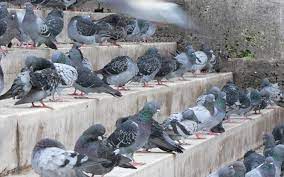
by Pigeon Patrol | Feb 16, 2022 | Bird Spike, Pigeon Spikes, Pigeons, Pigeons in the News, Raccoons, Sparrows
Be patient with a family of pigeons
If the babies have already hatched, really the only thing you can do is wait for them to grow up and fly away. Don’t worry — baby pigeons grow up very quickly! The time between when they hatch from the egg to when they fly away from their nest is usually less than 4 weeks. Once they leave, the babies don’t come back to the nest again.
The parents may try to start another nest in the same spot, even before the first babies have grown up and flown off. Read on to find out how to keep them from nesting on your balcony in the future.
Can’t I just move the nest?
No. Pigeons are very location-specific when it comes to their nest site. Moving the nest over even a few feet — say to a neighbouring balcony — can cause the parents to abandon the nest.
Baby pigeons NEED their parents — they cannot survive without them. Their parents feed them, keep them warm, and even after they’ve left the nest mom and dad show them how to fly, escape from predators, and integrate with the flock.
If you take the babies off of your balcony and move them, even if it’s to a “nice” spot like the local park, they will die. The best thing to do is to let the parents raise this one set of babies. It will take less than a month, they grow up so fast. Once the babies have flown away, you can prevent the pigeons from nesting again in the future.
Keep things tidy
Clean up or put away any things you might be storing on your balcony that are providing shelter or hiding spots for the pigeons to nest. Sweep away any feces or nesting material. It’s fine to do this cleaning while the babies are still on the balcony, just stay away from the exact spot the nest is in.
Remember, the parent pigeons may lay a new set of eggs before the first babies are grown up and gone. You will have to be diligent and go outside every day to sweep away any fresh nesting material. Eventually, the pigeons will get the message that your balcony is not a good place to nest, and they’ll go elsewhere.
What if they lay another set of eggs?
If they do lay a new set of eggs, provided you know that they were laid less than a week ago, it’s fine to dispose of them. We recommend taking them to the local park and hiding them under a bush – that way they can go back to being a part of nature.
If there is a new set of eggs and you’re not sure when they were laid, or you know they’re over two weeks old, we recommend leaving them be and letting the parents raise that brood. Pigeons usually incubate their eggs for about 3 weeks, and then the babies take about 4 weeks to grow up after hatching.

How to keep pigeons from nesting in the future
There are a few different things you can try to make your balcony less attractive to pigeons looking for a place to nest. Remember to wait until AFTER the babies have grown up and flown away before implementing any of these measures. You don’t want to separate the babies from their parents – they will die without their mom and dad.
Keep things tidy
Keeping things tidy and uncluttered is the first step. Pigeons like to choose a sheltered nest spot, so they like furniture and storage items to hide behind. Going out every day and sweeping off any new nesting material is the best thing you can do to prevent pigeon nests. Even just your presence out on the balcony will be enough to discourage many pigeons from nesting. We usually find that nests are made when no one is using the balcony, either early in the season or when the occupants have been out of town for a while.
Keep pigeons from perching
Adult pigeons like to perch on the railing of their nest-site balcony, so they can look around and spot any nearby predators. If you make it impossible to perch on the railing, they’ll usually find somewhere else to go.
We recommend a single length of wire or heavy gauge fishing line. Secure the line tautly about 2-3 inches above and parallel to the balcony railing. Tying it to nails or screws at either end can work. Pigeons aren’t technically perching birds, so it’s hard for them to stand on a piece of wire so thin. They won’t want to build their nest on a balcony where they can’t look out for predators.
Commercial flexible pigeon coils and wires can also work, but will be more expensive to install. We never recommend the use of sticky deterrents, because they can harm both pigeons and other species of birds.
Scare the pigeons away from the balcony
The best thing to scare pigeons away from a balcony is frequent human presence. We usually find that nests are made when no one is using the balcony, either early in the season or when the occupants have been out of town for a while.
You can also use visual deterrents to keep pigeons away from your balcony. Strips of shiny wrapping paper blowing in the breeze, old CDs hanging from string, and colourful spinning pinwheels are some cheap and easy options. Any visual deterrent will be more effective if you move it around or change it up regularly.
And no, those plastic owls don’t really work. At least not for pigeons.
Be careful with pigeon netting
Completely netting in a balcony or ledge can be a very effective way of keeping pigeons from nesting or roosting in that spot. However, pigeon netting MUST be professionally installed and regularly maintained! When pigeon netting gets loose and floppy, it becomes a danger to pigeons, hawks, sparrows, and any other birds that might fly into it and get tangled up.
It is also important to wait until any active nests are finished and all babies have flown away before installing pigeon netting. If the babies are separated from their parents, they will die.
Pigeon Patrol Products & Services is the leading manufacturer and distributor of bird deterrent (control) products in Canada. Pigeon Patrol products have solved pest bird problems in industrial, commercial, and residential settings since 2000, by using safe and humane bird deterrents with only bird and animal friendly solutions. At Pigeon Patrol, we manufacture and offer a variety of bird deterrents, ranging from Ultra-flex Bird Spikes with UV protection, Bird Netting, 4-S Bird Gel and the best Ultrasonic and audible sound devices on the market today.
Voted Best Canadian wholesaler for Bird Deterrent products ten years in a row.
Contact us at 1- 877– 4– NO-BIRD, (604) 585-9279 or visit our website at www.pigeonpatrol.ca
Pigeon/Pigeon Patrol / Pigeons Roosting / Vancouver Pigeon Control /Bird Spikes / Bird Control / Bird Deterrent / Pigeon Deterrent? Surrey Pigeon Control / Pest /Seagull deterrent / Vancouver Pigeon Blog / Birds Inside Home / Pigeons in the cities / Ice Pigeons/ What to do about pigeons/ sparrows , Damage by Sparrows, How To Keep Raccoons Away, Why Are Raccoons Considered Pests/ De-fence / Pigeon Nesting/ Bird Droppings / Pigeon Dropping/ woodpecker control/ Professional Bird Control Company/ Keep The Birds Away/ Birds/rats/ seagull/pigeon/woodpecker/ dove/sparrow/pidgeon control/pidgeon problem/ pidgeon control/flying rats/ pigeon Problems/ bird netting/bird gel/bird spray/bird nails/ bird guard

by Pigeon Patrol | Feb 7, 2022 | Pigeon Predators, Pigeon Spikes, Pigeons, Pigeons in the News, Raccoons, Sparrows, UltraSonic Bird Control
A local wildlife organization is concerned about the number of sick pigeons it’s finding in Regina’s downtown.
Megan Lawrence, director of rehabilitation for Salthaven West, said her organization is frequently called for reports of pigeons in distress.
She said Salthaven has been dealing with the birds for years now and fears they might have been poisoned.
“On average we’re seeing a poisoned pigeon every two to three weeks,” she said, adding those numbers increase in the summer. “It’s not a very humane death. Their temperature skyrockets; it can be a very painful death.”

“By the time we receive them, they’re having violent seizures,” she said. “The only thing we can do to get rid of the poison in their system is basically flush it out.”
Lawrence said she’s heard that some businesses downtown may be using poison in order to detract the birds from congregating on rooftops and other roosting points on buildings. However, she wasn’t able to offer any proof for her claims or pinpoint specific businesses and said she hasn’t spoken to any business owners herself.
The Leader-Post contacted some downtown businesses to see how they control the pigeon population. None of the businesses who responded said they use poison or have had an issue with pigeon overpopulation.
Kevin Lang, building manager for the Ramada Plaza located on Victoria Avenue, said while he has inquired with pest control companies about using poison to stop pigeons from roosting on the hotel’s roof, he’s never used it.
“I’ve been told … it affects the other (types of) birds,” he said. “(If) you put poison out, it can be consumed by anything that lands on our roof, which is not environmentally friendly.”
Instead, the hotel uses cages to keep them out. He said without them, pigeons can get into ventilation equipment and leave feathers in the rooftop coils.
Lawrence said if pigeons ingest poison, they aren’t the only ones who suffer. Animals who eat pigeons could be affected.
“If a Peregrine falcon was to eat one of those pigeons that had ingested the poison, the falcon is also going to get the poison and perhaps die as well,” she said.
Half of the pigeons they receive, she said, end up dying.
Salthaven’s most recent call to assist a pigeon was Wednesday evening. That one ended up dying. The organization doesn’t usually have pigeons tested to see what specific poison is making them sick, but it’s considering sending that one in for testing.
Lawrence believes the pigeons may be ingesting Avitrol, a bird control product she said is used in cities across Canada.
“It’s very common … to control pigeon populations this way,” she said. “It’s likely (because) it’s cheap and easy.”
In an email, the City of Regina said it doesn’t have a pigeon control program and doesn’t monitor pigeon populations.
On its website, the makers of Avitrol say the product “causes behaviours similar to an epileptic seizure.”
“Birds eating the treated bait will emit distress signals used by their species when they are frightened or injured,” the website says. “This will frighten the flock and cause it to leave the site.”
Several Regina pest control companies contacted by the Leader-Post said they do offer Avitrol, but it can only be administered in commercial and industrial areas and isn’t for retail sale. A trained pest control employee must administer it.
Instead of poison, Lawrence recommends removing structures where pigeons could roost and screen off air conditioning units where they might drink water from. Bristling wires, which prevent pigeons from landing, can also be purchased from a pest control retailer and installed.
“If they’re up on the roof and you start seeing them build nest, remove all nesting materials,” she said. “The more times that happens they’re going to realize this isn’t a place (they can) nest.”
Source
Pigeon Patrol Products & Services is the leading manufacturer and distributor of bird deterrent (control) products in Canada. Pigeon Patrol products have solved pest bird problems in industrial, commercial, and residential settings since 2000, by using safe and humane bird deterrents with only bird and animal friendly solutions. At Pigeon Patrol, we manufacture and offer a variety of bird deterrents, ranging from Ultra-flex Bird Spikes with UV protection, Bird Netting, 4-S Bird Gel and the best Ultrasonic and audible sound devices on the market today.
Voted Best Canadian wholesaler for Bird Deterrent products ten years in a row.
Contact us at 1- 877– 4– NO-BIRD, (604) 585-9279 or visit our website at www.pigeonpatrol.ca
Pigeon/Pigeon Patrol / Pigeons Roosting / Vancouver Pigeon Control /Bird Spikes / Bird Control / Bird Deterrent / Pigeon Deterrent? Surrey Pigeon Control / Pest /Seagull deterrent / Vancouver Pigeon Blog / Birds Inside Home / Pigeons in the cities / Ice Pigeons/ What to do about pigeons/ sparrows , Damage by Sparrows, How To Keep Raccoons Away, Why Are Raccoons Considered Pests/ De-fence / Pigeon Nesting/ Bird Droppings / Pigeon Dropping/ woodpecker control/ Professional Bird Control Company/ Keep The Birds Away/ Birds/rats/ seagull/pigeon/woodpecker/ dove/sparrow/pidgeon control/pidgeon problem/ pidgeon control/flying rats/ pigeon Problems/ bird netting/bird gel/bird spray/bird nails/ bird guard

by Pigeon Patrol | Feb 7, 2022 | Bird Spike, Pigeon Predators, Pigeon Spikes, Pigeons, Pigeons in the News, Raccoons, Sparrows
Where do you go for your daily headlines? Your stock prices? Certainly not your neighborhood pigeons. Thomson Reuters, also known as The Answer Company, is the world’s largest provider of news and information to businesses and professionals. As early as the 1850s, they were sending news of bond prices across the English Channel on carrier pigeons.
Thomson Reuters, also known as The Answer Company, is the world’s largest provider of news and information to businesses and professionals. As early as the 1850s, they were sending news of bond prices across the English Channel on carrier pigeons.
Lincoln’s assassination was first reported into Europe by Baron Reuter, and he did it by sending fishing ships out to catch the steamers as they were coming across the Atlantic and getting back first. So being first, and being fast is paramount to Thomson Reuters, and it has been since day one.
Though much has changed and evolved since the days of its first office in the city of London where they transmitted share price quotes to Paris via the new Dover-Calais telegraph cable, what hasn’t changed is the responsibility to supply mission-critical news to businesses around the world.
With the rapid rise in digital advancements, what has changed, is the vast amount of information to manage. Professionals are consuming the news via mobile apps on various devices, portfolio management is influenced by headlines, and machines can be programmed to perform trades based upon market fluctuations. Getting it first is vitally important in the news business. Thomson Reuters leans on speed to meet the needs of today’s digital customers. Rapidity and accuracy is a duty its customers count upon them to fulfill; a duty they take seriously.
News Travels Fast
Using SAP HANA, they’ve been able to double the speed at which they can ingest polling data and get more than a tenfold increase in the way they analyze that data. Running live on SAP allows them to do what used to take days, and do it almost instantaneously.
A good example of this is the Polling Explorer. As you can imagine, the use of the polling explorer was widespread during the 2016 pre-elections. Today, Thomson Reuters’ polling data is easily interrogated. Back in the early eighties however, polling data meant a big book of data that landed on your desk with a thud, and this would be only the highlight results. If you really wanted to analyze that data, you would have to ask for cross-tabs to be created. It would take hours, if not days, to analyze what-ifs. With today’s level of data interactivity, running SAP HANA means getting a live data experience.
Source
Pigeon Patrol Products & Services is the leading manufacturer and distributor of bird deterrent (control) products in Canada. Pigeon Patrol products have solved pest bird problems in industrial, commercial, and residential settings since 2000, by using safe and humane bird deterrents with only bird and animal friendly solutions. At Pigeon Patrol, we manufacture and offer a variety of bird deterrents, ranging from Ultra-flex Bird Spikes with UV protection, Bird Netting, 4-S Bird Gel and the best Ultrasonic and audible sound devices on the market today.
Voted Best Canadian wholesaler for Bird Deterrent products ten years in a row.
Contact us at 1- 877– 4– NO-BIRD, (604) 585-9279 or visit our website at www.pigeonpatrol.ca
Pigeon/Pigeon Patrol / Pigeons Roosting / Vancouver Pigeon Control /Bird Spikes / Bird Control / Bird Deterrent / Pigeon Deterrent? Surrey Pigeon Control / Pest /Seagull deterrent / Vancouver Pigeon Blog / Birds Inside Home / Pigeons in the cities / Ice Pigeons/ What to do about pigeons/ sparrows , Damage by Sparrows, How To Keep Raccoons Away, Why Are Raccoons Considered Pests/ De-fence / Pigeon Nesting/ Bird Droppings / Pigeon Dropping/ woodpecker control/ Professional Bird Control Company/ Keep The Birds Away/ Birds/rats/ seagull/pigeon/woodpecker/ dove/sparrow/pidgeon control/pidgeon problem/ pidgeon control/flying rats/ pigeon Problems/ bird netting/bird gel/bird spray/bird nails/ bird guard
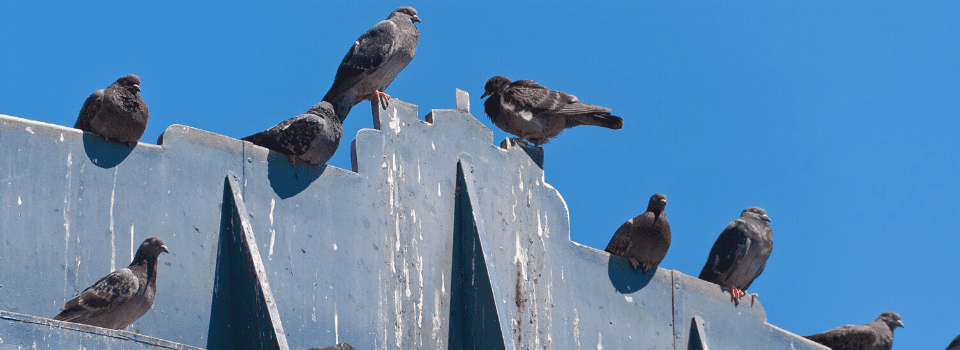
by Pigeon Patrol | Feb 7, 2022 | MBCA, pet bird, Pigeon Control, Pigeon Droppings, Pigeon Patrol's Services, Pigeon Predators
Contractors tackling the long-running pigeon problem at the Scottish Parliament have issued a warning about the potential health risks of bird muck on the building
This is not a recent problem. It was obvious from occasional visits years ago.
Maybe if it had been a more conventional design, this bizarre occurrence wouldn’t be happening.
Keep those windows open to ventilate for covid but never mind what untold diseases you might catch from pigeons.
Aberdeen train station has a weird electronic bird of prey which seems to keep pigeons away. The recording of the screeching sound is quite convincing and the silhouette is quite good too. The mechanical wing movement, not so much.
Would imagine they won’t be long in throwing resources at it unlike the damp and infestation in the housing that they turn a blind eye to.
Pigeons have done more for the people of the UK than that place. Flatten it, sack them and plant some trees.
Well that may be the excuse the other parties needed to say the SNP is suffering from mad doo disease!
Has anyone considered what the poor pigeons might catch from those that are already in that place.
Pigeons are more astute than I gave them credit for!
Is this not an issue at the new infirmary building too?
Chuck a loaf or two of bread on the building a day, keep them well fed.
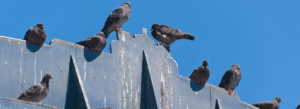
I work in a pharmacy and we (so far) have had supplies coming in daily. We were only without any for a couple of hours and that’s only because people were constantly coming in for them, don’t panic there will be enough.
They were handing them out in Dobbies the other day; don’t know if they do this every day.
Costco were giving them out today.
Testing should only be done when someone feels unwell.
I made a fortune from my mates, isolation over in time for the New Year.
You can get them at testing center’s – got one today.
Yes, always managed to get them online or at the local chemist.
Shambles! Cheese and wine more important!
Yes, I was given some last week when I had my booster.
No, can’t find any. I’m asthmatic and have COPD – it scares me that I can’t find any.
Handing them out in Midlothian Community Hospital.
Yes, got some yesterday at Ainslie Park Leisure Centre.
Piershill has become a battleground of wills between residents and the council over how bins should be serviced
Edinburgh council should give themselves a round of applause. Well done in transforming one of the most beautiful cities in the world into a third world slum.
Source
Pigeon Patrol Products & Services is the leading manufacturer and distributor of bird deterrent (control) products in Canada. Pigeon Patrol products have solved pest bird problems in industrial, commercial, and residential settings since 2000, by using safe and humane bird deterrents with only bird and animal friendly solutions. At Pigeon Patrol, we manufacture and offer a variety of bird deterrents, ranging from Ultra-flex Bird Spikes with UV protection, Bird Netting, 4-S Bird Gel and the best Ultrasonic and audible sound devices on the market today.
Voted Best Canadian wholesaler for Bird Deterrent products ten years in a row.
Contact us at 1- 877– 4– NO-BIRD, (604) 585-9279 or visit our website at www.pigeonpatrol.ca
Pigeon/Pigeon Patrol / Pigeons Roosting / Vancouver Pigeon Control /Bird Spikes / Bird Control / Bird Deterrent / Pigeon Deterrent? Surrey Pigeon Control / Pest /Seagull deterrent / Vancouver Pigeon Blog / Birds Inside Home / Pigeons in the cities / Ice Pigeons/ What to do about pigeons/ sparrows , Damage by Sparrows, How To Keep Raccoons Away, Why Are Raccoons Considered Pests/ De-fence / Pigeon Nesting/ Bird Droppings / Pigeon Dropping/ woodpecker control/ Professional Bird Control Company/ Keep The Birds Away/ Birds/rats/ seagull/pigeon/woodpecker/ dove/sparrow/pidgeon control/pidgeon problem/ pidgeon control/flying rats/ pigeon Problems/ bird netting/bird gel/bird spray/bird nails/ bird guard
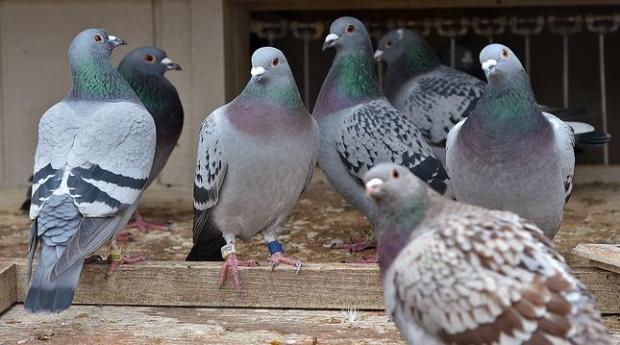
by Pigeon Patrol | Feb 7, 2022 | 4-S Gel Bird repellent, Animal Deterrent Products, Bird Deterrent Products, Bird Law, Bird Netting, Bird Spikes
Mattawa’s pigeon feeders have been warned—the free lunches stop now.
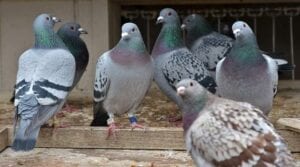
Council recently approved a bylaw prohibiting the feeding of pigeons, a ban that encompasses the entire municipality.
Cracked corn, seeds, cereal grains, wheat, and barley make delectable dishes for pigeons, and many people enjoy indulging this aviary desire to while away some time, or to make the birds’ lives a little easier.
But for Mattawa residents the practice is no longer accepted. And those who continue distributing the seed may be fined $250.
See: Pigeon poop proves a problem. Police involved
Moreover, if one attracts pigeons, and this flock results in a public nuisance, another fine of $250 can be issued. This is separate from the feeding fine. Think twice before installing that pigeon motel in your garden.
The bylaw came about after the municipality received numerous complaints regarding the birds over the past year.
“Pigeons are destroying rooftops, property, and our beautiful downtown area with their feces,” explained Councillor Loren Mick, in his report to council.
“The biggest problem” he noted is also the most preventable: “people feeding them.”
Hence the bylaw to remove “unwanted pigeon pests,” which will “promote the use and enjoyment of property in a healthy and sanitary manner.”
Source
Pigeon Patrol Products & Services is the leading manufacturer and distributor of bird deterrent (control) products in Canada. Pigeon Patrol products have solved pest bird problems in industrial, commercial, and residential settings since 2000, by using safe and humane bird deterrents with only bird and animal friendly solutions. At Pigeon Patrol, we manufacture and offer a variety of bird deterrents, ranging from Ultra-flex Bird Spikes with UV protection, Bird Netting, 4-S Bird Gel and the best Ultrasonic and audible sound devices on the market today.
Voted Best Canadian wholesaler for Bird Deterrent products ten years in a row.
Contact us at 1- 877– 4– NO-BIRD, (604) 585-9279 or visit our website at www.pigeonpatrol.ca
Pigeon/Pigeon Patrol / Pigeons Roosting / Vancouver Pigeon Control /Bird Spikes / Bird Control / Bird Deterrent / Pigeon Deterrent? Surrey Pigeon Control / Pest /Seagull deterrent / Vancouver Pigeon Blog / Birds Inside Home / Pigeons in the cities / Ice Pigeons/ What to do about pigeons/ sparrows , Damage by Sparrows, How To Keep Raccoons Away, Why Are Raccoons Considered Pests/ De-fence / Pigeon Nesting/ Bird Droppings / Pigeon Dropping/ woodpecker control/ Professional Bird Control Company/ Keep The Birds Away/ Birds/rats/ seagull/pigeon/woodpecker/ dove/sparrow/pidgeon control/pidgeon problem/ pidgeon control/flying rats/ pigeon Problems/ bird netting/bird gel/bird spray/bird nails/ bird guard
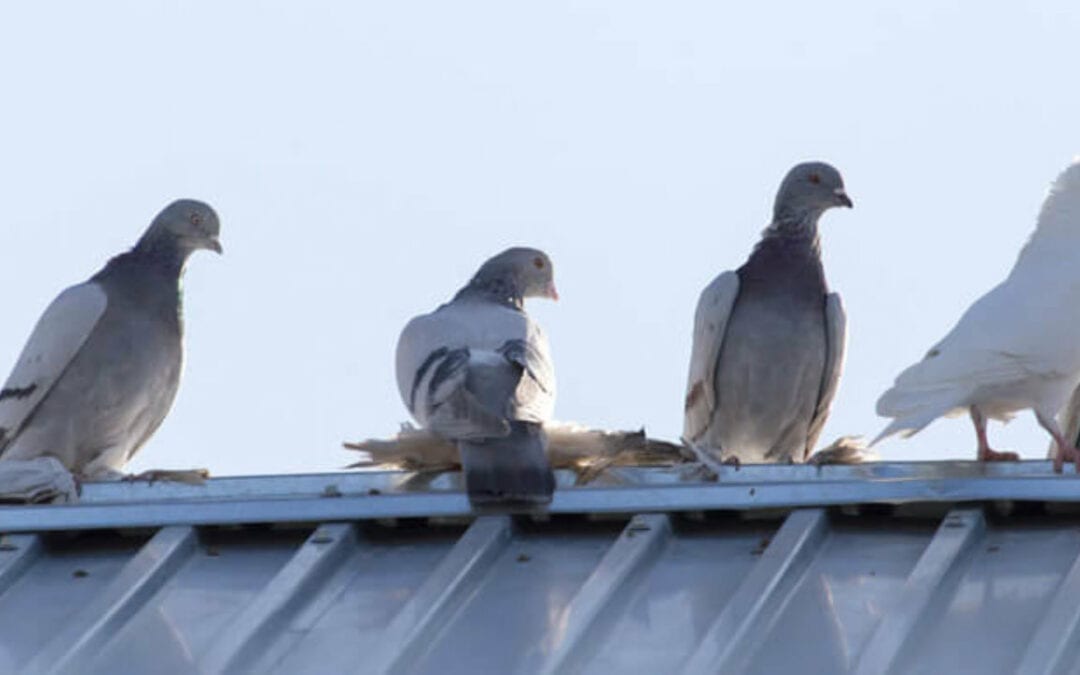
by Pigeon Patrol | Feb 7, 2022 | Pigeon Spikes, Pigeons, Pigeons in the News, Raccoons, Sparrows, UltraSonic Bird Control
A Toronto resident recorded a video of a man snatching pigeons in the city’s east end and when she tried to report it to officials, she said no one wanted to investigate.
On Sunday morning, Bruna Doberstein was on her way home when she witnessed a man and a child capturing the birds with a net and placing them inside a crowded cage in a parking lot at Lawrence Avenue East and Markham Road. That’s when she decided to take out her phone and start recording.
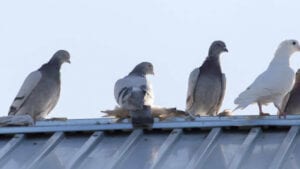
“I expected he would stop doing it after he saw that I was recording. But he didn’t. He seemed pretty comfortable doing it,” Doberstein told CityNews.
In the video, you can hear Doberstein asking the man why he was trapping the pigeons and that he “can’t do this,” in which he responds “Yes I can. I take them to my farm and I raise them.”
Doberstein said she didn’t buy it.
“He wasn’t being gentle. He was holding the birds by their wings. A person who would raise the birds would be at least careful and keep them safe” she said. “I don’t know the story but I know it’s not good.”
At that moment, Doberstein decided to call the police. She said that while the officer was courteous, she was told that it wasn’t their jurisdiction and they wouldn’t be sending an officer.
Instead they told her to call 311. But she said from past experience, Doberstein didn’t think they would be of any help in this matter.
This wasn’t the first time she witnessed the man capturing a cage full of birds and it also wasn’t the first time she tried reporting on what she witnessed.
“It was the second time I saw this guy. I recognized the truck from almost a year ago in August in the same parking lot.”
She told CityNews that last year she contacted a variety of different municipal and provincial departments with no luck, “I called PAWS (Provincial Animal Welfares services) and The Ministry of Nature and Forestry too and I never heard back.”
This kind of response isn’t unusual, according to Camille Labchuck, animal rights lawyer and executive director of Animal Justice.
“In my experience this is not uncommon when it comes to animal issues and law enforcement agencies,” said Labchuck. “Because a lot of people have authority also means that nobody does, leading to nobody wanting to pick it up and run with it.”
While Labchuck and her team are disappointed that Toronto Animal Services and police didn’t do more, they ultimately had more success with reporting the incident to Provincial Animal Welfare Services and the Ministry of Natural Resources and Forestry.
“PAWS is the agency that took over enforcement from the OSPCA two years back. They are tasked with investigating any animal cruelty problems.” Labchuck explained. Something many people may not be aware of.
Since the OSPCA announced in 2019 it will no longer enforce animal cruelty laws, there has been no clear guidance of who one should contact to report, investigate and enforce animal cruelty laws.
“You got a man roughly handling birds by the wings which is not permitted,” Labchuck said. “To say nothing of the fact that he shouldn’t be interacting with pigeons anyways. They are protected species under the federal Migratory Bird Convention Act”.
The Ministry of Natural Resources and Forestry are in charge of enforcing the wildlife act. Labchuck said there could be a clear violation here as residents can’t interact with native wildlife without a permit.
However, while both departments took down information, neither would accept the video at this stage.
“They both advised that providing the video would be a next step if an enforcement officer requires it. Kind of bizarre as it’s relevant evidence at the outset,” Labchuck said.
In 2015, the illegal trapping of pigeons became a widespread issue in the city of New York after hundreds were believed to be stolen for live pigeon shoots in neighbouring states.
Source
Pigeon Patrol Products & Services is the leading manufacturer and distributor of bird deterrent (control) products in Canada. Pigeon Patrol products have solved pest bird problems in industrial, commercial, and residential settings since 2000, by using safe and humane bird deterrents with only bird and animal friendly solutions. At Pigeon Patrol, we manufacture and offer a variety of bird deterrents, ranging from Ultra-flex Bird Spikes with UV protection, Bird Netting, 4-S Bird Gel and the best Ultrasonic and audible sound devices on the market today.
Voted Best Canadian wholesaler for Bird Deterrent products ten years in a row.
Contact us at 1- 877– 4– NO-BIRD, (604) 585-9279 or visit our website at www.pigeonpatrol.ca
Pigeon/Pigeon Patrol / Pigeons Roosting / Vancouver Pigeon Control /Bird Spikes / Bird Control / Bird Deterrent / Pigeon Deterrent? Surrey Pigeon Control / Pest /Seagull deterrent / Vancouver Pigeon Blog / Birds Inside Home / Pigeons in the cities / Ice Pigeons/ What to do about pigeons/ sparrows , Damage by Sparrows, How To Keep Raccoons Away, Why Are Raccoons Considered Pests/ De-fence / Pigeon Nesting/ Bird Droppings / Pigeon Dropping/ woodpecker control/ Professional Bird Control Company/ Keep The Birds Away/ Birds/rats/ seagull/pigeon/woodpecker/ dove/sparrow/pidgeon control/pidgeon problem/ pidgeon control/flying rats/ pigeon Problems/ bird netting/bird gel/bird spray/bird nails/ bird guard

























 Thomson Reuters, also known as The Answer Company, is the world’s largest provider of news and information to businesses and professionals. As early as the 1850s, they were sending news of bond prices across the English Channel on carrier pigeons.
Thomson Reuters, also known as The Answer Company, is the world’s largest provider of news and information to businesses and professionals. As early as the 1850s, they were sending news of bond prices across the English Channel on carrier pigeons.




